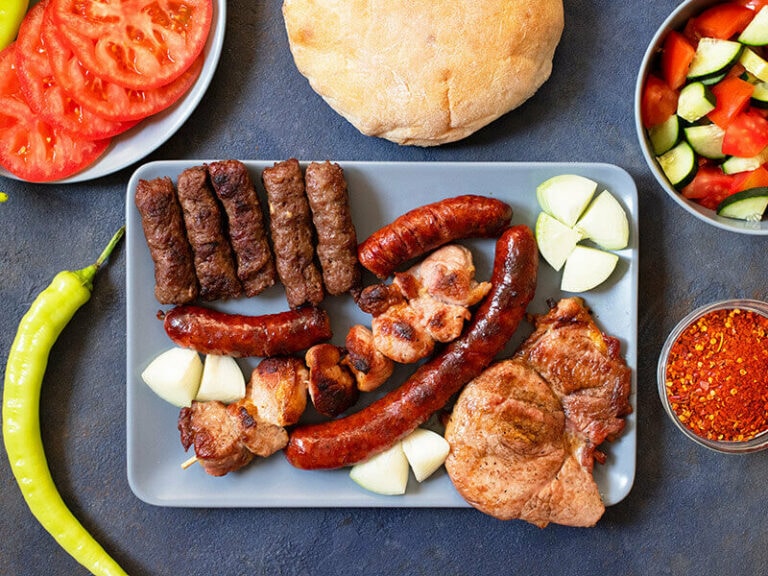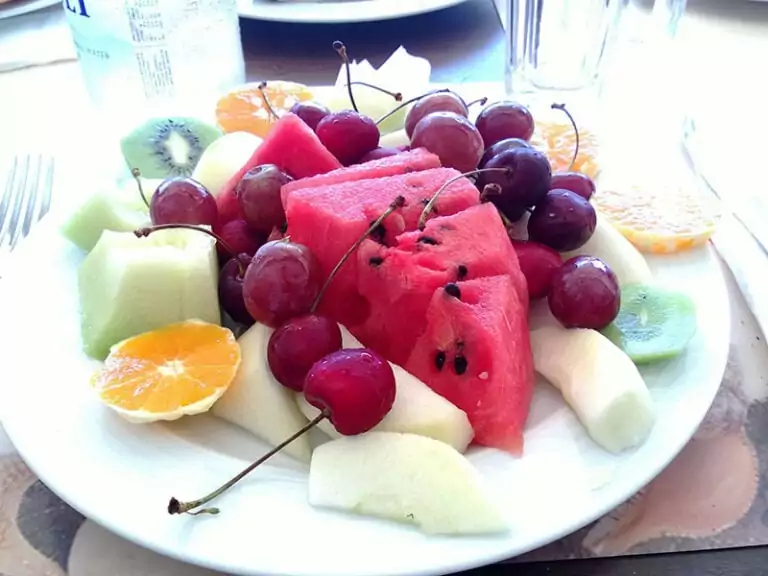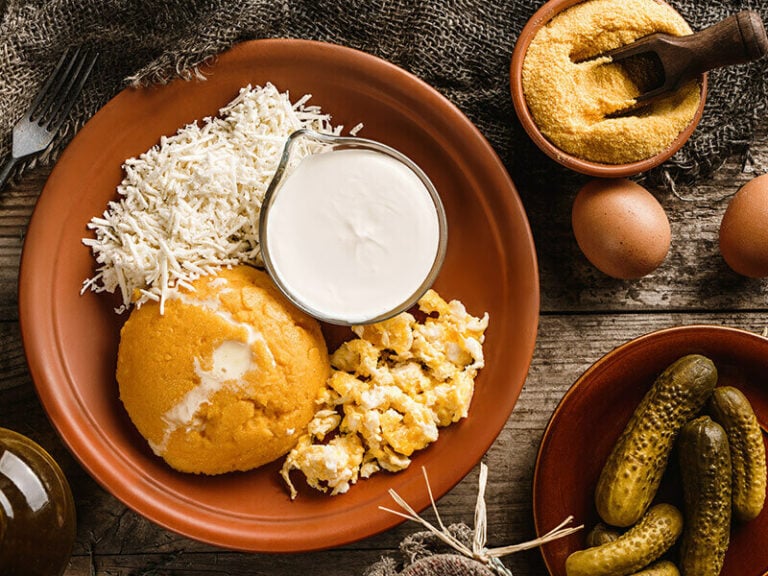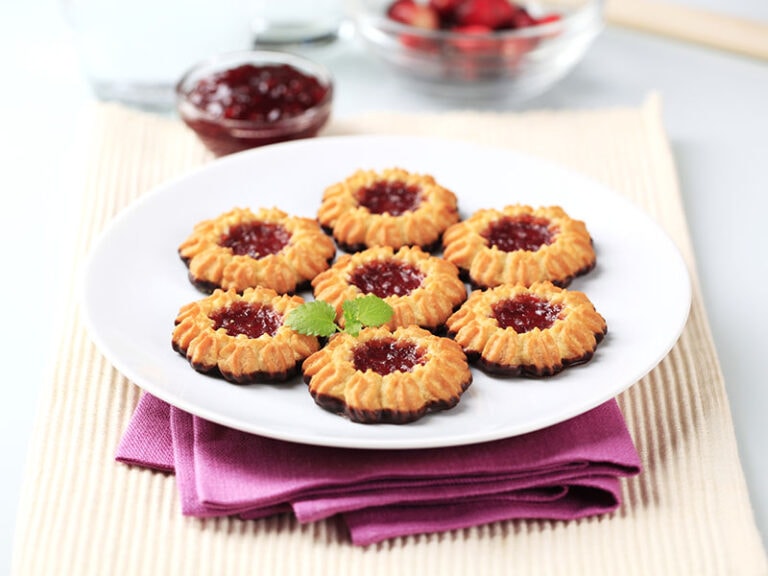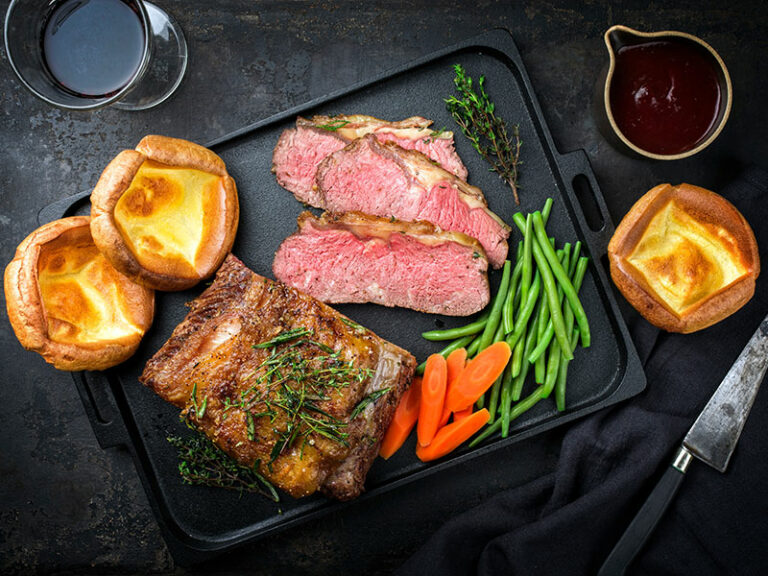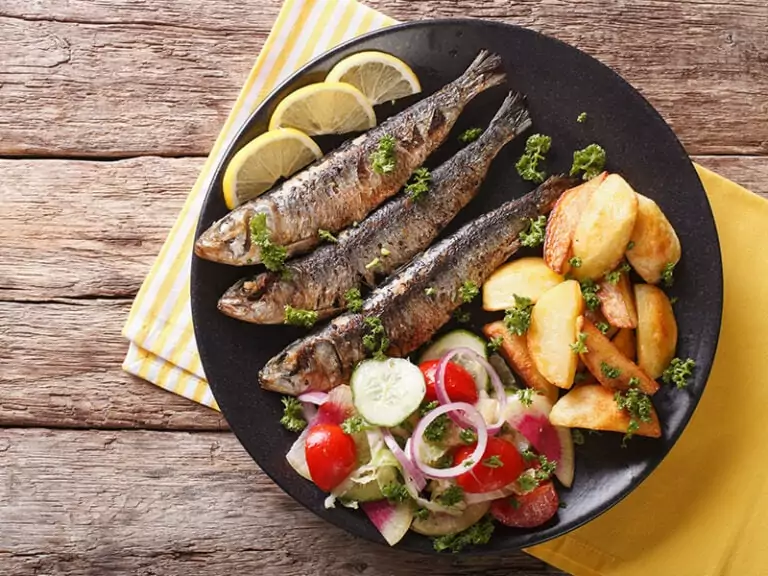In the vast culinary landscape, traditional Central European dishes have a charm of their own that continues to captivate the global palate. I believe you should get to know these dishes because they offer a rich blend of flavors and history.
By diving into these culinary treasures, you’ll learn about the special preparation methods, understand the cultural significance of each dish, and even master recipes that have been passed down through generations.
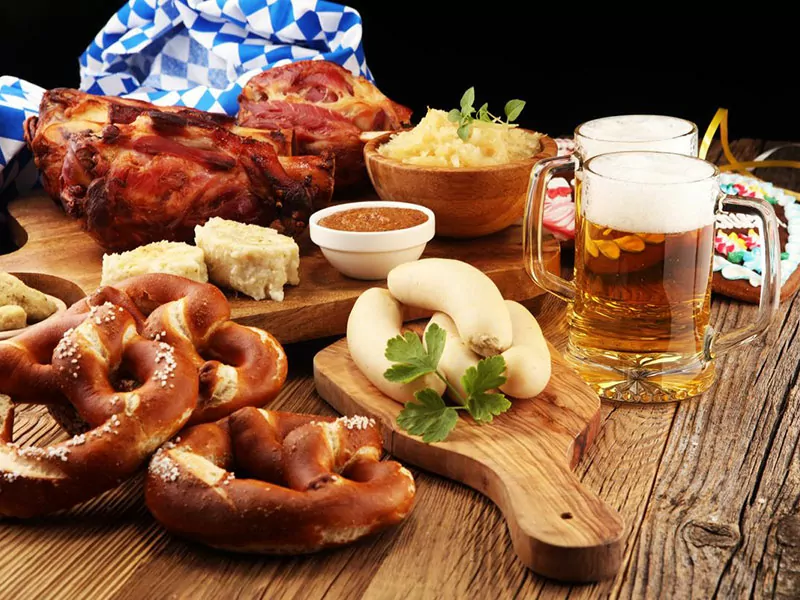
Definition And Geographical Context Of Central Europe
Central Europe, as a term, refers to the region lying between Eastern and Western Europe. While the precise countries it encompasses can be subject to debate, generally, it includes Germany, Austria, Hungary, Poland, the Czech Republic, Slovakia, Switzerland, etc.
This geographical hub has cultivated a distinct blend of traditions, languages, and, remarkably, a cornucopia of heritage dishes from Europe that are as diverse as they are delicious.
From the robust flavors of Germany to the delicious dishes of Hungary and Poland, each country contributes its zest to the Central European culinary landscape.
The geography of Central Europe, with its rolling hills, fertile plains, and substantial bodies of water, has significantly influenced the food produced and consumed in this region.
Influence Of History And Cultural Exchange
Central Europe’s cuisine, steeped in a diverse history and shaped by dynamic cultural exchanges, is a testament to the region’s rich tapestry of European history. Throughout history, this region has seen various rulers and kingdoms, wars, periods of prosperity, and migration, each leaving its culinary mark.
The nomadic Magyars, for example, introduced the practice of slow-cooking meats, which eventually evolved into traditional Hungarian dishes like goulash.
Similarly, with its legacy of grandeur, the Austro-Hungarian Empire profoundly influenced the region’s cuisine, introducing luxurious ingredients and elaborate baking traditions.
Trade routes and migrations also played a key role. The medieval spice trade brought ingredients like black pepper, ginger, and saffron to the region.
The movement of people, whether through war, displacement, or the search for better opportunities, also contributed to culinary exchange and innovation.
Furthermore, historic events of the 20th century had their impact. The two World Wars and the subsequent periods of scarcity led to a culture of resourcefulness in cooking, using every part of an animal, for example.
Characteristics Of Central European Cuisine
Overview Of Common Ingredients And Cooking Methods
Central European food culture is diverse and varies from country to country, but some common ingredients tie it together.
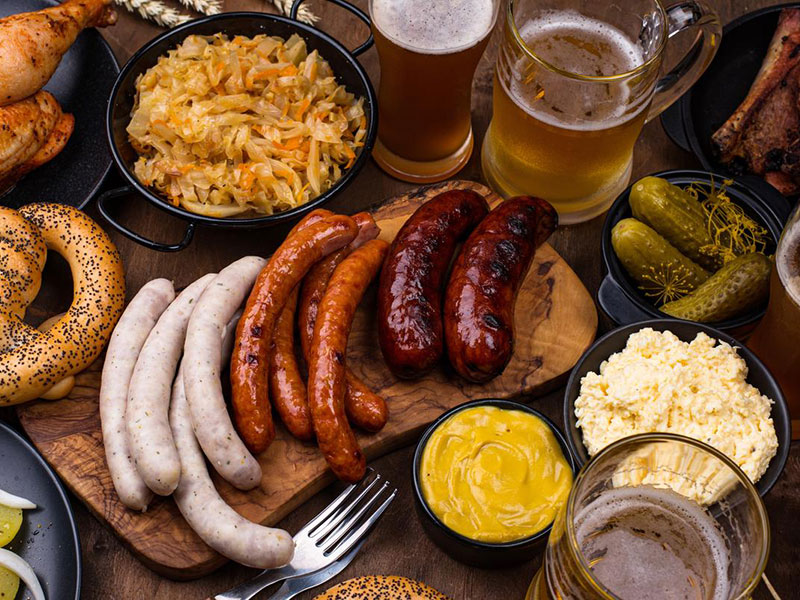
- Meat, especially pork, beef, and poultry, plays a significant role in many dishes, whether in stews, roasts, or sausages.
- Fish is also enjoyed, particularly in areas close to rivers or the sea. Dairy products, such as cheese and cream, are extensively used, contributing richness to many dishes.
- Root vegetables, including potatoes, carrots, beets, cabbages, onions, and legumes, are dietary staples. Grains are also crucial, with wheat, rye, and barley being used to make bread, dumplings, and noodles.
- Essential European herbs and spices are generously used to impart delicious flavors to Central Europe dishes. While each country has its signature spice blends, some commonly used seasonings include paprika in Hungary, caraway seeds in Germany and Austria, and dill in Poland.
- For cooking methods, roasting, stewing, and baking are prevalent. These methods are known to enhance the flavors of the ingredients, resulting in dishes that are comforting and deeply satisfying.
Influence Of The Seasons And Local Produce
Central European cuisine is also deeply influenced by the seasons and the local produce they bring. Winter sees preserved foods and warming dishes like stews and roasts.
Spring and summer introduce a bounty of fresh vegetables and fruits, leading to lighter fare, including salads, soups, and fruit-based desserts. Autumn is the time for harvesting grains and root vegetables, reflected in the many bread-based dishes and potato meals.
Moreover, there is a strong emphasis on using locally sourced ingredients, which not only ensures freshness but also supports local farmers and industries.
Impact Of Traditions And Festivals On Food Culture
Easter, harvest festivals, and other religious or cultural celebrations all come with their special dishes. The preparation of these dishes often involves family and community participation, thus serving as a means to pass down culinary traditions from one generation to the next.
Many dishes are closely tied to specific celebrations or times of the year. For example, in Germany, Christmas is incomplete without Stollen (German Christmas Bread). In Poland, Fat Thursday is celebrated with the consumption of Pączk (Doughnuts).
Poland
1. Bagel
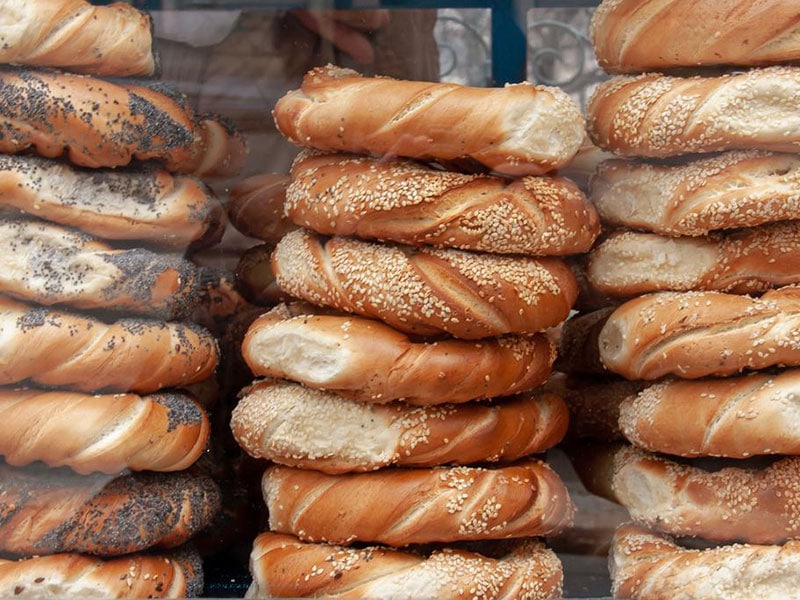
Born in Poland’s Jewish communities, the bagel, or “Bajgiel” as it’s known in Polish, has become a favorite snack and a staple breakfast food in Poland as well as around the world.
This bread roll, hand-shaped into a roughly palm-sized ring from yeasted wheat dough, undergoes a two-step cooking process: a brief boil in water, followed by baking, lending it a dense, chewy interior beneath a browned, occasionally crisp exterior.
Additionally, bagels come in different varieties, some crafted from whole-grain or rye dough. Seeds – poppy, sesame, or a sprinkling of salt – baked onto the outer crust lend extra flavor and texture.
The topping game is flexible, too, with popular favorites like cream cheese and lox. Despite its deceptively simple appearance, the humble bagel has more calories than an average slice of bread.
2. Kielbasa
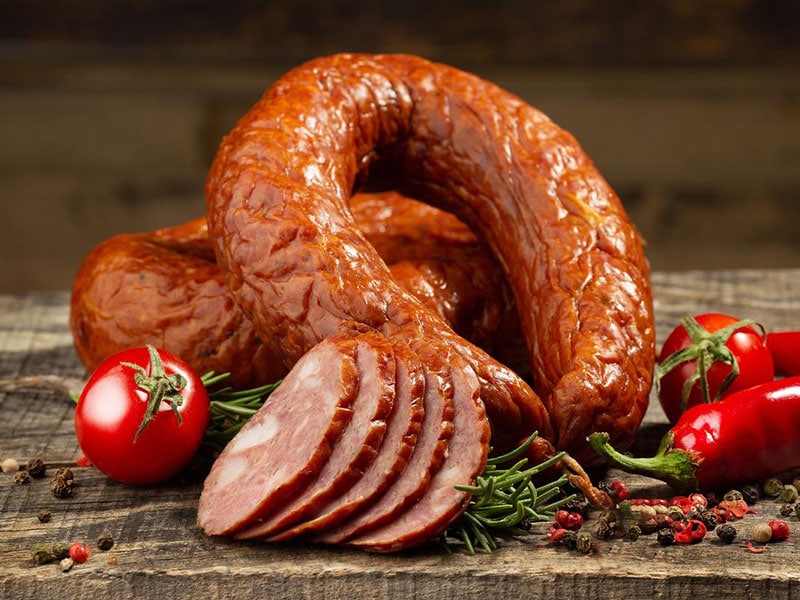
Kielbasa is a meaty sausage that’s pretty much a national staple. From pork and beef to turkey, lamb, chicken, or veal, the variety in kielbasa will leave you amazed as the region proudly presents its own specialty, making every new town a flavor expedition.
Three kielbasas even carry the honor of being Traditional Specialities Guaranteed in the UK and EU: Kiełbasa jałowcowa staropolska, Kiełbasa krakowska sucha staropolska, and Kiełbasa myśliwska staropolska.
When I attended a Polish wedding, kielbasa was the celebratory fare, highlighting its cultural significance. Rural areas cherish homemade versions, with family recipes passed down generations.
One that everyone kept mentioning was the “Kiełbasa Polska”. Kielbasa has versatile serving options. It can be cold or hot, boiled, baked, or grilled. The smoked ones are served with a garnish of fried onions. They’re also an excellent addition to soups, which I enjoyed on colder days.
3. Makowiec (Poppy Seed Roll)
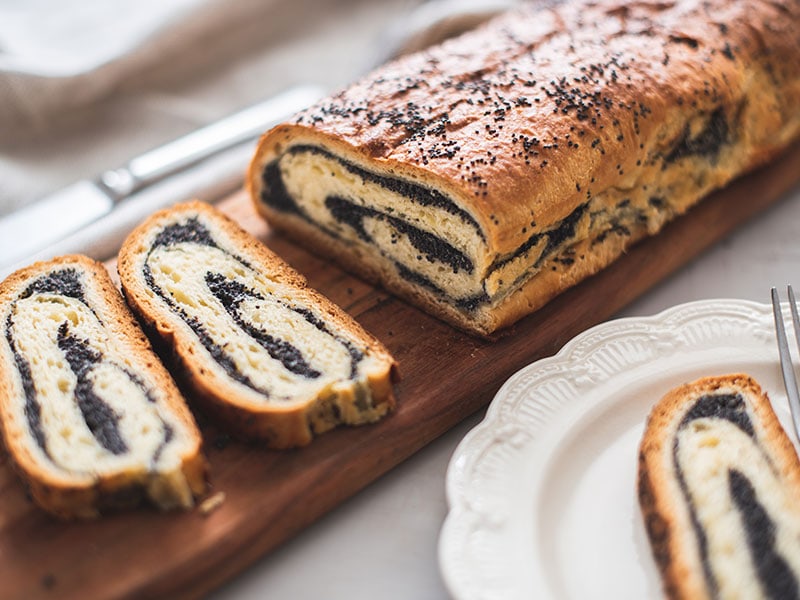
Makowiec, a sweet yeast bread roll, is a dessert that you’d love to have. The pastry boasts a filling that’s a tasty contrast – bittersweet, dense, and rich, made primarily from poppy seeds.
There’s a choice of fillings, with minced walnuts or chestnuts standing in as alternatives. From Central Europe cuisine to parts of Eastern Europe cuisine, the popularity of Makowiec is noticeable, especially during Christmas and Easter.
The dough is made of flour, sugar, egg yolk, milk or sour cream, butter, and yeast, resulting in a smooth texture that’s a pleasure to bite into.
The process of creation is a spectacle. The filling is spread, the dough is then rolled into a long cylinder, and some might even add a hint of lemon or orange zest, or rum. Brushed with egg white and baked until golden brown on a sheet pan, it’s a feast for the eyes.
4. Pierogi (Dumpling)
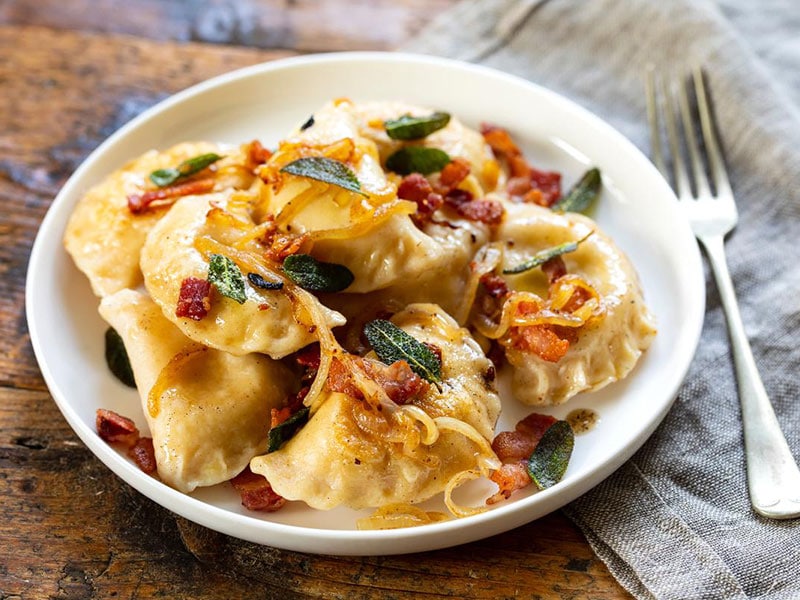
Pierogi, the national dish of Poland, is a type of dumpling that shares similarity with Varenyky from Russia and Ukraine. Saint Hyacinth of Poland brought them from the Far East (Asia) in the 13th century.
Originating as peasant food, pierogi have a special place in cultural traditions, playing a part in mourning or wakes and even during the caroling season in January [1].
These dumplings are stuffed with various fillings – from fresh quark, boiled and minced potatoes, and fried onions, to ground meat, mushrooms, cabbage, and an assortment of fruits for dessert versions.
Sweet pierogi come served with sour cream mixed with sugar, while savory ones come with bacon fat and bacon bits. There’s also a smaller version known as Kołduny, served in broth.
5. Golonka (Pork Hock)
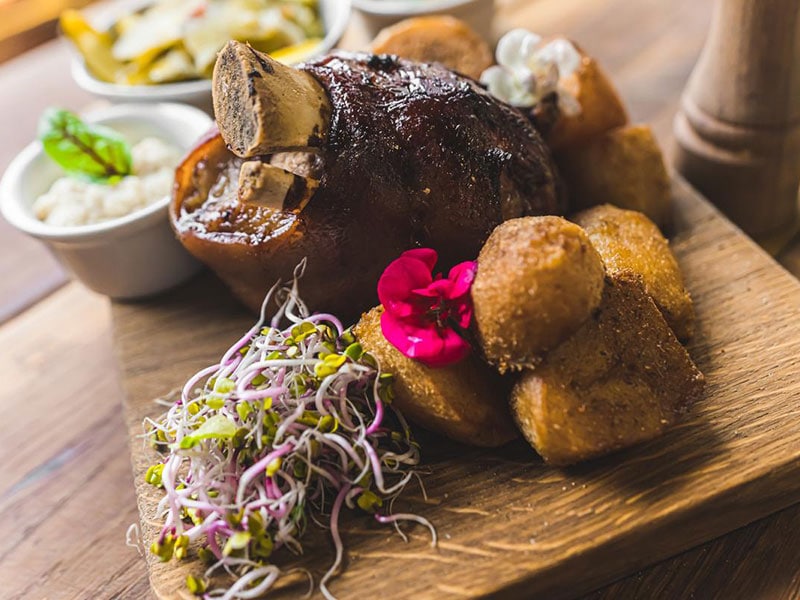
Golonka, another national dish of Poland, is a savory stewed pork knuckle or hock. This meaty masterpiece is usually seared and then slow-cooked until it reaches a tender, melt-in-your-mouth consistency.
Depending on regional preferences, it can also be grilled or oven-braised, showcasing the dish’s versatility. Presented in all its glory, Golonka is served whole, right on the bone. Its usual companions at the dinner table are boiled potatoes, cabbage, and cooked vegetables.
For those who relish a bit of kick, it pairs well with horseradish or mustard sauce. One particular way I savor Golonka is with beer and honey sauce, which brings out a delicious combination of flavors.
It’s similar to Eisbein, a German culinary dish, and the Swedish fläsklägg med rotmos, emphasizing how food connects cultures.
6. Klopsy / Klops / Pulpety (Polish Meatballs)
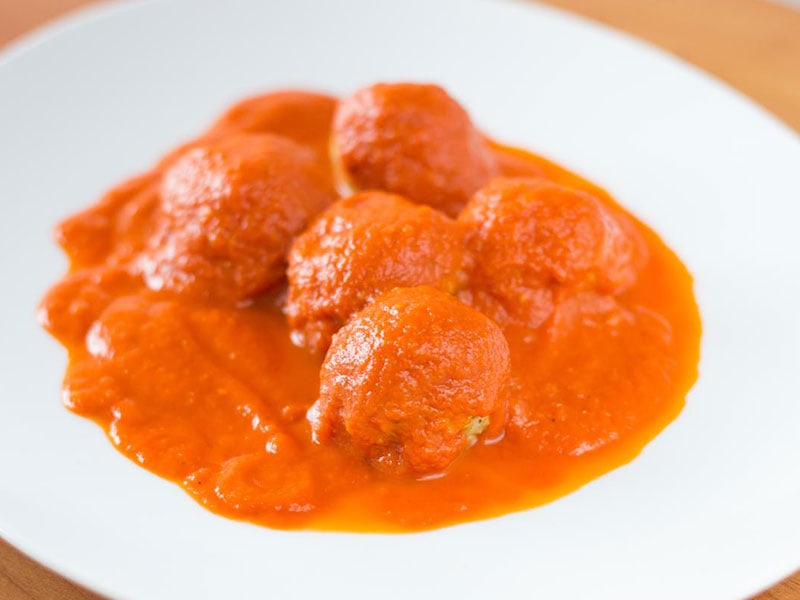
In Polish culinary tradition, Klopsy, also known as Klops or Pulpety, are notable dishes. These are meatballs prepared with ground pork, beef, or sometimes chicken or game.
Alongside the chosen meat, breadcrumbs or soaked bread, eggs, and a mix of spices and herbs get incorporated into the mix. Once formed, they’re cooked in a few ways – pan-fried, simmered, or slowly braised in broths full of flavor.
After cooking, Klopsy is paired with diverse sauces, such as tangy tomato or rich forest mushroom sauce, depending on personal preference. They find the company in a plate with potatoes, rice, or kasza, a kind of Polish grain.
You might also encounter the fried variety, known as mielony, which is larger, flatter, but just as delicious!
7. Kopytka (Potato Dumplings)
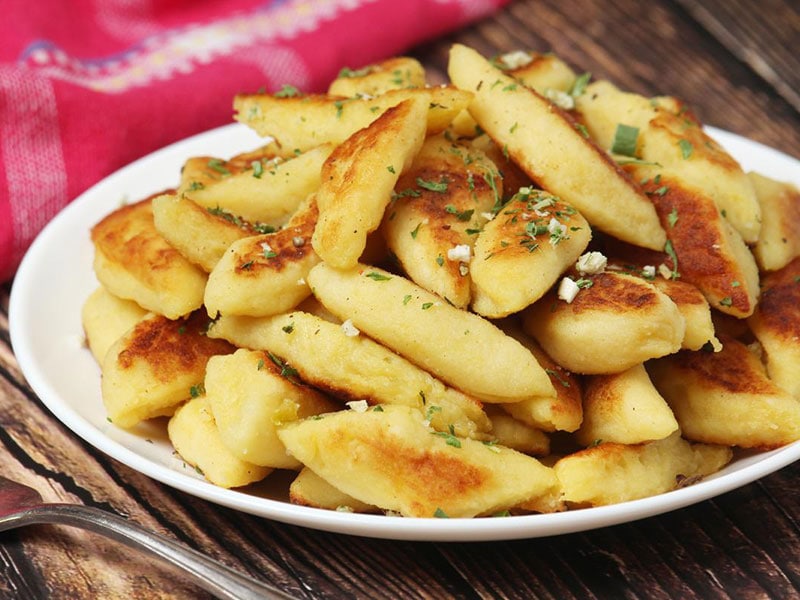
Kopytka, a type of Polish potato dumpling, has left a mark on me. These dumplings have much in common with Italian gnocchi. However, their diamond shape, resembling cloven hooves, hence their name ‘Kopytka’ or ‘little hooves’, adds a unique touch.
They’re made with the humblest ingredients – boiled potatoes and flour, a dash of salt, eggs, and a mix of other seasonings. In Poland, Kopytka is typically cooked in salted water, and it’s their versatility that I love so much.
They can be the star of the meal or play a supporting role as a side dish, shining equally in both roles. Some folks savor them savory, baked with cheese, alongside fried bacon or onion, or under a hearty helping of goulash or mushroom sauce.
Others, like me, love to relish them sweet, coated in melted butter and sugar, or sprinkled with cinnamon. One of my personal favorites? Kopytka served with a dollop of sweetened quark. Alternatively, you can go for a simple combination of sugar with sour cream alongside Kopytka.
8. Rosół (Chicken Soup)
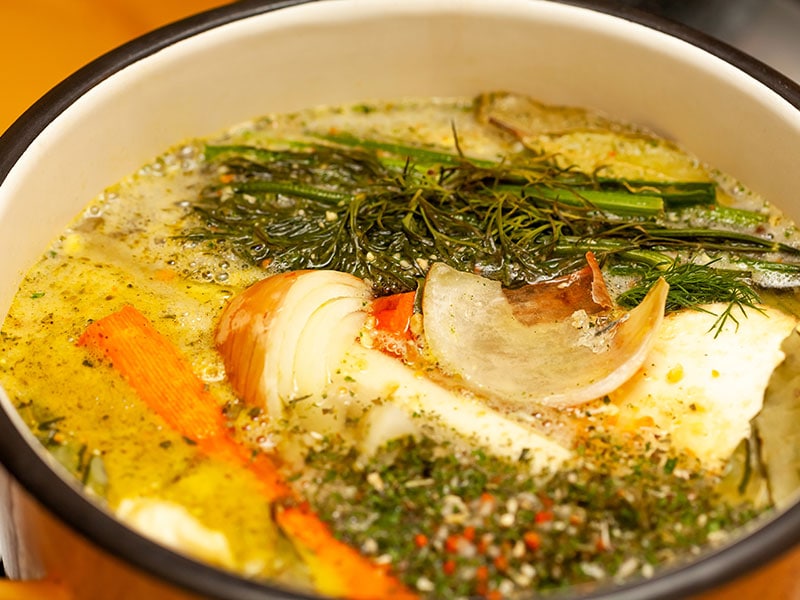
There’s something incredibly comforting about Rosół, a traditional Polish chicken soup. This soup is a cornerstone of Polish family dinners, and it even stars as a dish at weddings.
But its role doesn’t stop at festivities, as it doubles as a soothing remedy for the common cold. The base of this delicious dish is a meat broth, typically chicken for the most popular version, known as Rosół z kury.
It’s simply tasty, especially when served with capellini pasta. Rosół also has a royal side, known as Rosół Królewski, and a version dedicated to the outdoorsy folk, the Rosół myśliwski. For those leaning towards a plant-based lifestyle, a vegetarian version is also available, where meat is replaced with oil or butter.
I’ve had the pleasure of savoring Rosół as a starter in traditional restaurants, and it’s a soothing classic that’s usually relished over the weekend.
9. Zapiekanka (Toasted Baguette)
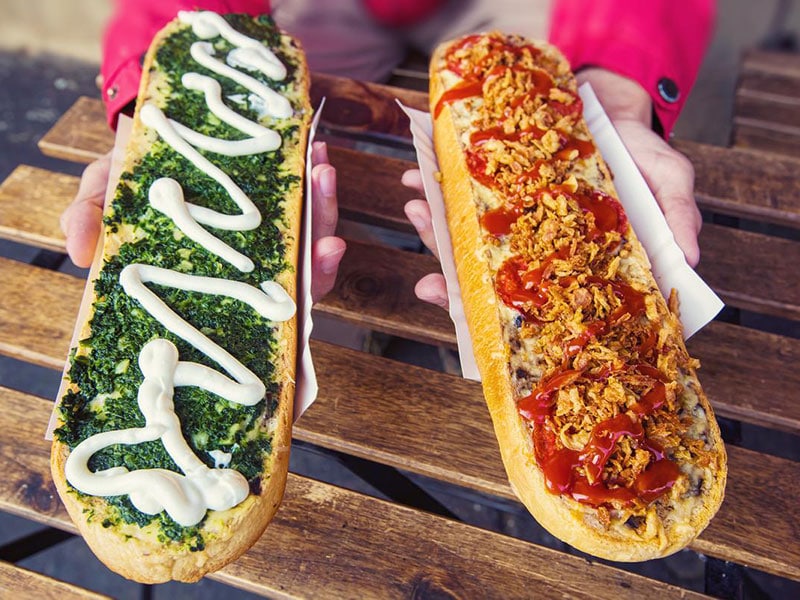
Zapiekanka, or Zapiekanki in the plural, has been a favorite street food of Poland with its irresistible charm since the 1970s. Picture this: a toasted open-face sandwich crafted from a sliced baguette or another long roll of bread.
It’s generously topped with sautéed white mushrooms and melted cheese. Some versions might surprise you with a topping of ham. Hot off the grill, it’s served with a tangy drizzle of ketchup.
You’ll find these sandwiches available throughout Poland, with diverse varieties and quality levels. For those who prefer the comfort of home cooking, whipping up a Zapiekanka in your own kitchen is quite achievable.
10. Gołąbki (Stuffed Cabbage)
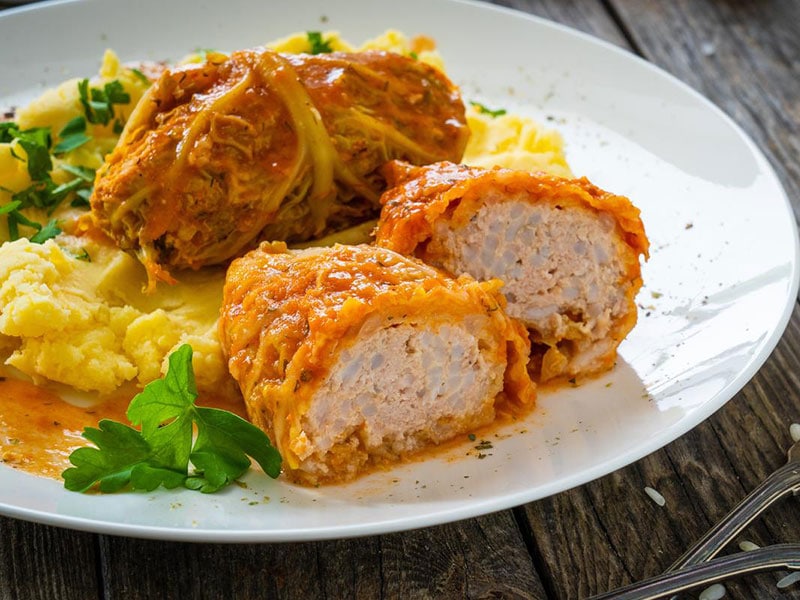
Gołąbki, charmingly named “little pigeons” in Polish, are a dish that has no relation to birds but brings immense joy to your tastebuds. These Polish-style cabbage rolls are generously stuffed with a mix of pork and beef, combined with rice or barley, all carefully nestled within a tender cabbage leaf.
Once they’re wrapped up like little gifts, they’re either baked in the oven or simmered on the stove until they achieve perfect tenderness. A popular dish in Polish cuisine, Gołąbki are immersed in a flavored broth, either simmered or baked, allowing them to soak up all the goodness.
And believe me, when I say this, they always taste even better on the second or even third day. When it’s time to serve, a tangy tomato sauce (the most popular option) or a savory mushroom sauce makes for the ideal companion.
11. Polish Sernik (Cheesecake)
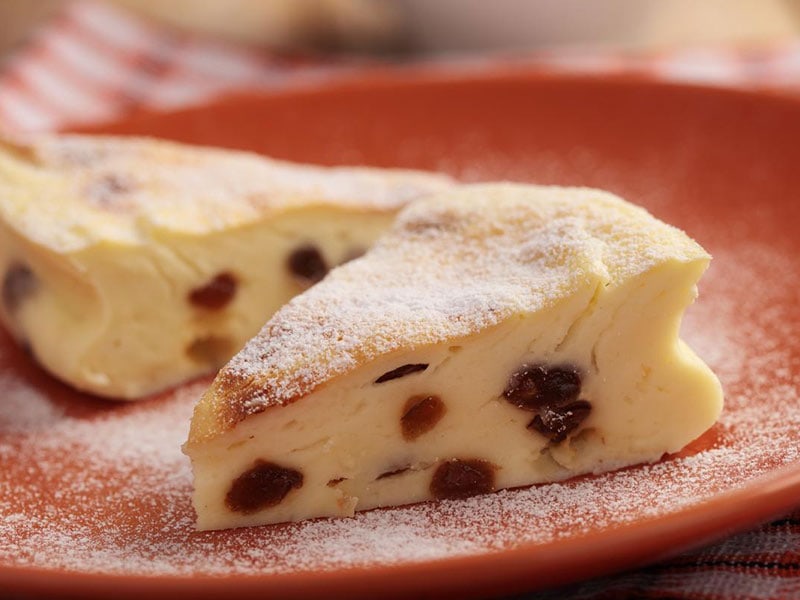
Sernik, a delightful Polish-style cheesecake, holds a special place on Polish tables. It has become a Polish favorite dessert since its arrival in the 17th century.
It starts with a sweet pastry crust that cradles a filling of twaróg, also known as ‘Ser Biały’, a type of farmer cheese that is as firm as it is creamy and boasts a pleasant mix of natural sweetness with a hint of sourness.
This combination then gets baked into a savory treat. There’s an impressive versatility to Sernik too. It may have a shortcrust or sour cream pastry base, but sometimes, it prefers to go without one.
The topping options further add to its charm – it could be another layer of pastry, either crumbled or arranged into a lattice, or it could be adorned with fruit, fruit sauce, fruit jello, nuts, chocolate ganache, or meringue. Paired with a cup of tea or coffee, Sernik effortlessly rounds off a meal.
12. Schabowy (Fried Pork Cutlets)
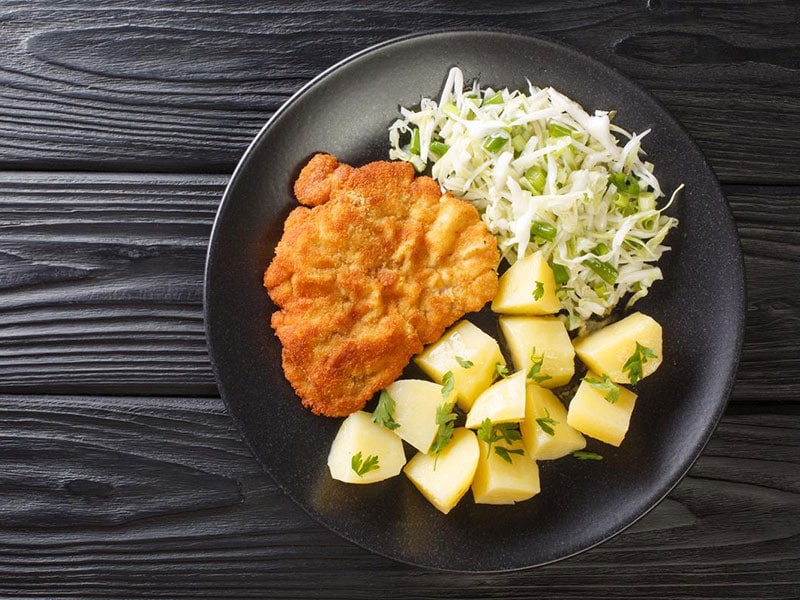
Schabowy is a breaded pork cutlet that bears a striking similarity to the Viennese schnitzel or the American milanesa. Its roots stretch back to the 19th century in Poland, and believe me, it’s as tasty as it is historic.
When I cook Schabowy, I start with slices of pork tenderloin. Here’s a tip: using a mallet to thin and soften the meat – it truly makes a difference. I then let the pork luxuriate in a marinade of milk and onions, which truly elevates the final taste.
The next stages involve a triple coating – first flour, then egg, and a final layer of breadcrumbs. In the kitchen, there’s something truly satisfying about hearing the meat sizzle as it hits the hot oil or lard in the frying pan.
That’s when you know it’s coming along just right. Each flip of the cutlet builds anticipation. The best part? Schabowy isn’t a solo act. I like pairing it with mashed potatoes, cooked vegetables like seared cabbage, fried mushrooms, salads, or coleslaw.
13. Bigos (Hunter’s Stew)
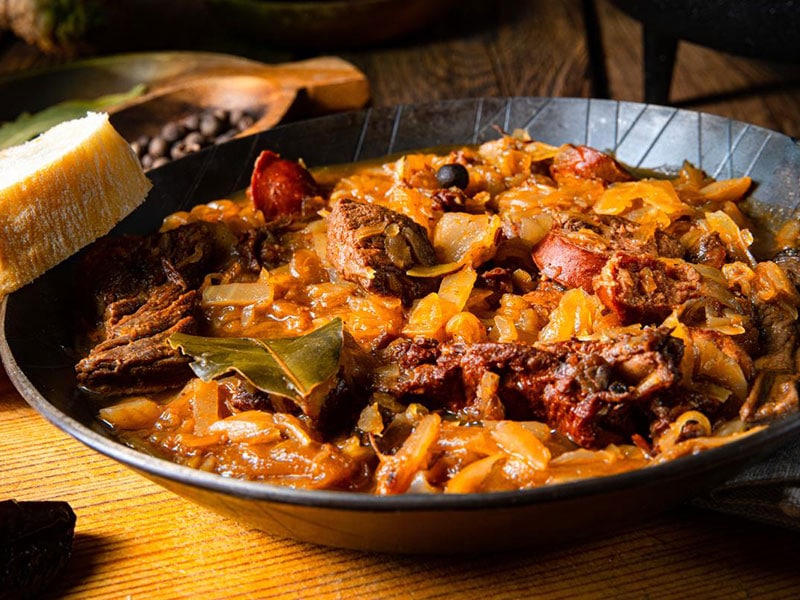
Bigos is a classic Polish hunter’s stew that brings back vivid memories of my first encounter with it, on a chilly day that was perfect for this warming dish. Its origins are in Poland, but it has become traditional in the vast areas of the Polish-Lithuanian Commonwealth.
Here’s what’s in Bigos: it’s a hearty blend of chopped meats stewed to perfection with sauerkraut and shredded fresh cabbage. The whole pot simmers until the flavors meld beautifully, creating a stew that’s served hot and can be amplified with a variety of vegetables, spices, or even a splash of wine.
What makes Bigos stand out is its ability to improve with each reheating, a characteristic that has made it a staple for travelers, campers, and outdoor events. But don’t mistake it for a strictly outdoor dish.
I’ve enjoyed it for breakfast, supper, and even as a hot starter before soup at dinner parties. And did I mention its special place at major Catholic holidays like Christmas and Easter? Preparing Bigos in advance and reheating it during the holiday days adds to its charm, making it a comforting and familiar presence at festive tables.
Czech Republic
14. Palačinky (Pancakes)
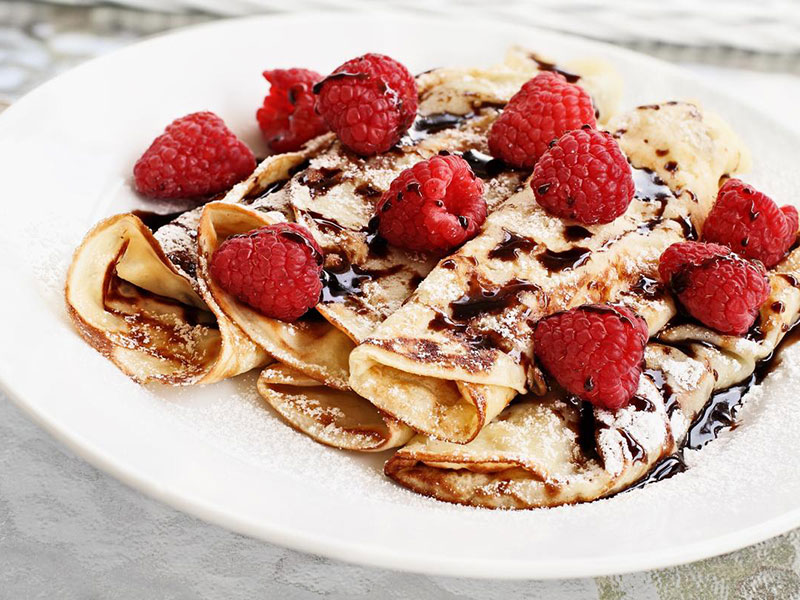
Palačinky, akin to French crepes or Austrian Palatschinken, is a marvel of culinary simplicity. A silky smooth batter is spread thinly on a round-shaped pan, acquiring a slightly brown hue as it fries on both sides.
With a neutral taste on its own, the palačinky becomes a canvas for various fillings. Traditionally, it gets brushed with sweet strawberry jam, carefully rolled, and dusted with a snowfall of icing sugar.
Ensuring a smooth batter is pivotal here – a quick tip: a blender can be your best ally in preventing lumps. Whether rolled up, folded, or filled, the Palačinky is ready to be served, promising a bite of soft, slightly sweet bliss.
15. Trdelník (Split Cake Treat)
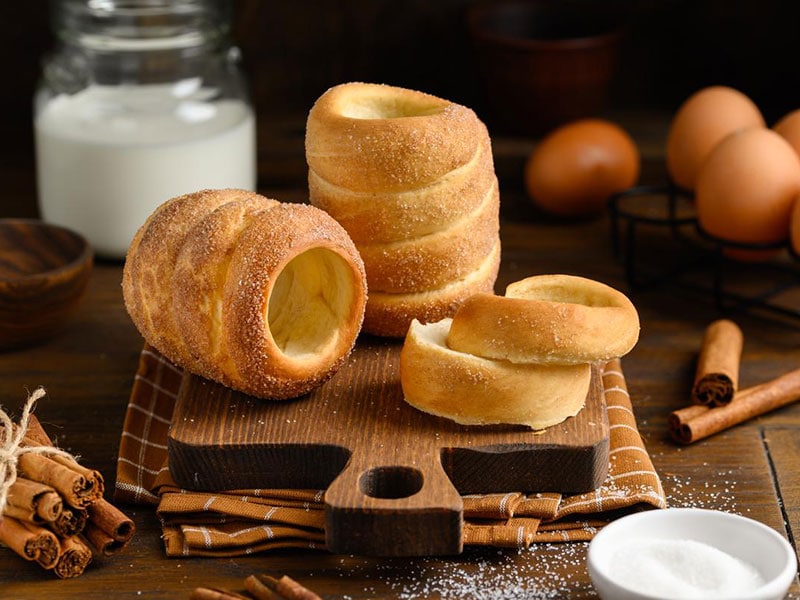
In the bustling streets of the Czech Republic, the scent of Trdelník, an alluring split cake, wafts through the air. This cake, often dubbed as a traditional Czech treat or old Bohemian pastry, attracts throngs of tourists with its unique baking method and tempting sweetness.
The dough is wrapped around a stick, known as trdlo in Czech-Slovak language, providing the treat its special name. Cooked until golden, it is then dusted with a sugar and walnut mix, creating a caramelized crust that is irresistibly worth trying.
An innovative twist from Prague cafés has also seen this delicacy filled with ice cream, amplifying its appeal. Despite its roots tracing back to the northern regions of the historical Kingdom of Hungary, Trdelník has certainly found its home in the hearts of Czech locals and tourists alike.
16. Svíčková (Roast Sirloin in Sour Cream Sauce with Dumplings)
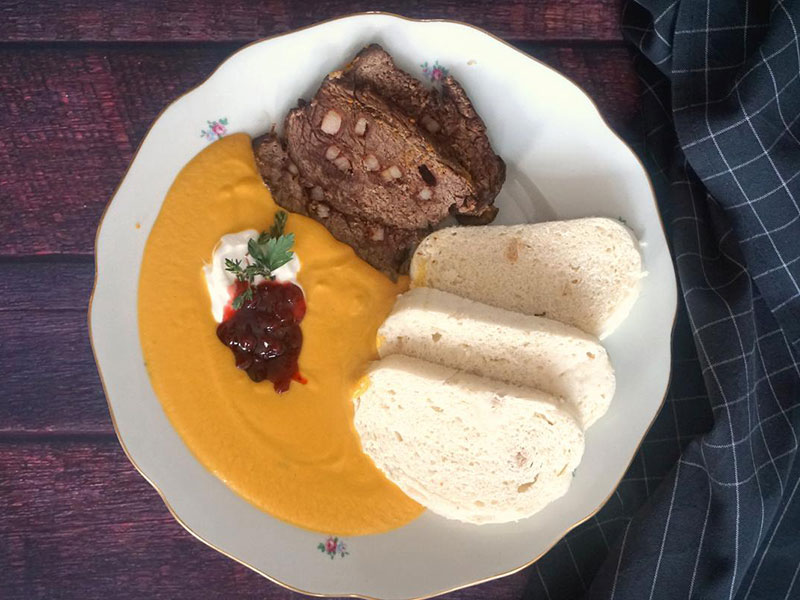
From the heart of Czech food culture emerges Svíčková, a roast sirloin dish soaked in a rich, tangy sour cream sauce. Its popularity extends to Slovakia, taking a beloved spot among their national meals.
Sirloin steak, partnered with a colorful mix of vegetables like carrots, parsley root, onion, and celeriac, cooks slowly, absorbing the fragrant notes of allspice, black pepper, thyme, and bay leaf.
The finale sees it swathed in luxurious double cream, achieving a depth of flavor that’s nothing short of mesmerizing. The customary sidekick, houskové knedlíky, or bread dumplings, adds a comforting heartiness.
And the choice of cranberry sauce or whipped cream offers an appetizing twist. This dish is more than just a meal; it’s a source of nostalgia and pride, with each Czech swearing by their family’s version as the unrivaled best.
17. Knedlíky (Czech Dumplings)
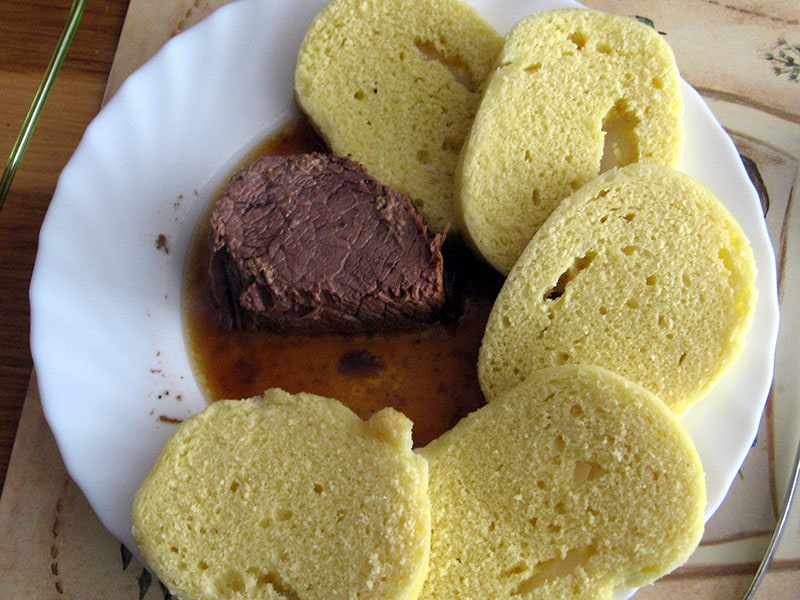
A symbol of Czech cuisine, Knedlíky, also known as Czech dumplings, graces tables as a go-to side dish. They’ve etched their own identity within the diverse spectrum of global dumplings, sharing similarities with the German knödel, Polish knedle, and Italian canederli.
Their distinctive character lies in a dough akin to that of bread, marrying flour, egg, yeast, salt, and bread cubes into a kneaded consistency. This dough is then carefully shaped into a cylindrical roll and subjected to a gentle boil or steam until it reaches the perfect texture.
As it emerges warm and comforting, it’s sliced and presented, eagerly awaiting the accompaniment of iconic Czech sauces like the tangy Svíčková or the sumptuous Rajská.
18. Pečená Kachna (Roast Duck)
Pečená kachna or roasted duck is more than a dish, it’s a centerpiece of celebration. Picture this: it’s a special occasion, perhaps the festive fall season called Hody or Posviceni, St. Václav’s Day on September 28, or even Christmas Day, when tradition dictates poultry on the table.
Amidst the merriment, the star attraction emerges from the kitchen – a golden brown, crispy roasted duck, its aroma intertwined with caraway seeds and marjoram. It’s a feast for the eyes and the taste buds, a culinary testament to slow roasting mastery.
Traditional Czech accompaniments – wholesome potatoes, bread dumplings, braised red cabbage – complement this centerpiece and bring together a symphony of flavors.
Sometimes, you might also find a thick, indulgent sauce made with reserved duck fat and flour. These home-prepared weekend meals or special occasion main dishes encapsulate Czech gastronomy’s spirit. It’s also a restaurant favorite, extending the celebration beyond home kitchens.
Austria
19. Apfelstrudel (Apple strudel)
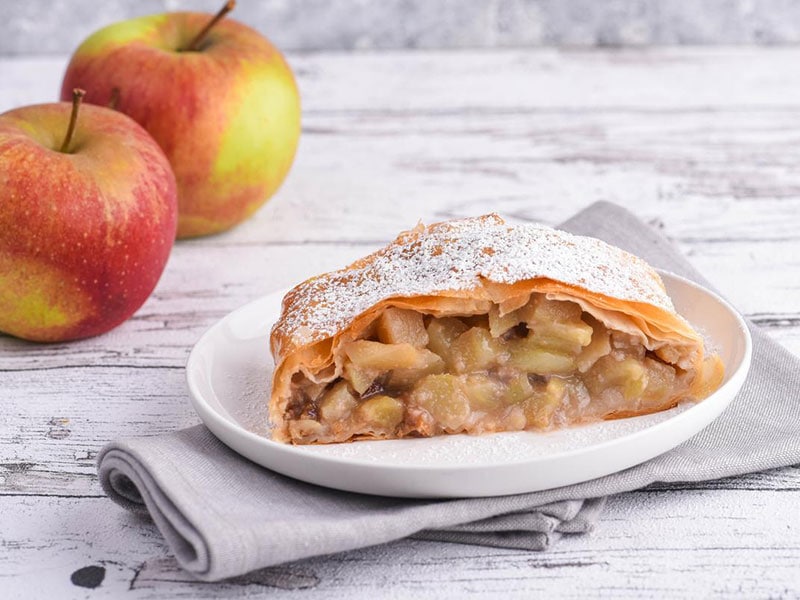
Meet Apfelstrudel, or apple strudeMeet Apfelstrudel, or apple strudel, a popular pastry loved not just in its home Austria but also in Bavaria, the Czech Republic, Northern Italy, Slovenia, and other European countries’ delicacy.
It’s Austria’s national dish, and its arrival is traced back to Hungary. Its simplicity is its strength – an oblong pastry jacket that wraps around a heart of apple filling. The pastry dough, made of flour, oil (or butter), and salt, is thin, elastic, and unleavened.
Within this cradle lies the star of the show: the filling. Grated cooking apples, usually tart, crisp, and aromatic varieties like Winesap apples, are sweetened with sugar, spiced with cinnamon, and combined with bread crumbs.
20. Wiener Schnitzel (Breaded and Pan-fried Veal Cutlet)
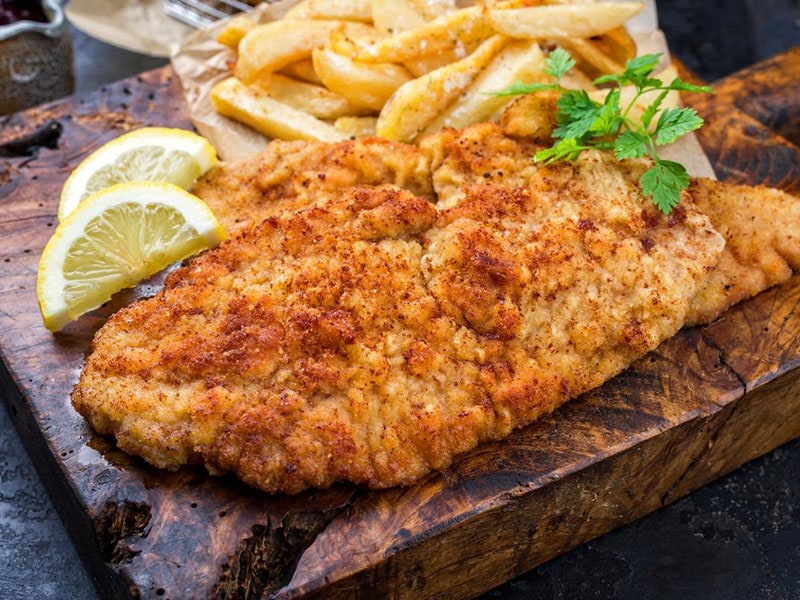
A key culinary icon of Austria, Wiener Schnitzel, or Wienerschnitzel, is a creation of Viennese cuisine. Thin veal cutlets are breaded and pan-fried to achieve a beautiful balance of textures. The exterior is crisp, while the interior is tender and flavorful.
As a national dish of Austria, Wiener Schnitzel comes with a strict rule: Austrian law insists on veal, although pork is a familiar stand-in, particularly in rural Austria. Fresh from the pan and piping hot, it’s traditionally served with lemon wedges and cranberry sauce.
Complementing it on the plate are choices like butterhead lettuce tossed in a sweet vinaigrette, perhaps with chopped chives or onions, potato salad, cucumber salad, parsley potatoes, rice, or even French fries.
21. Mozartkugel
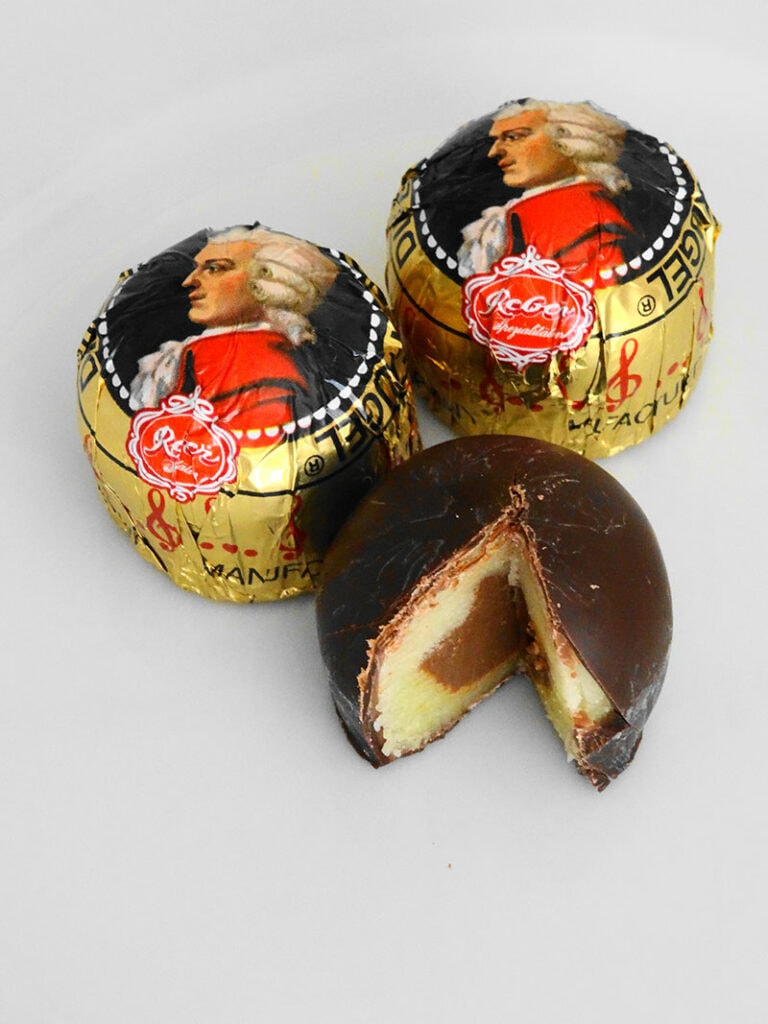
The Mozartkugel is a small, spherical delight, a tribute to culinary artistry and the genius of Wolfgang Amadeus Mozart. Confectioner Paul Fürst crafted this rich sugar confection in Salzburg in 1890, drawing inspiration from Mozart’s legacy [2].
The delicate composition includes a harmonious blend of pistachio, marzipan, and nougat, elegantly robed in dark chocolate. Known initially as Mozart-Bonbon, its flavor, and fine ingredients justify the higher cost, offering an indulgent experience truly worth every cent.
Mozart Kugeln carries a tradition of quality and elegance, which mirrors the music of their namesake. Among the places to find them in Vienna are Lindt/Hofbauer, Gerstner, Billa Corso, and Leschanz.
22. Sachertorte (Chocolate Cake)
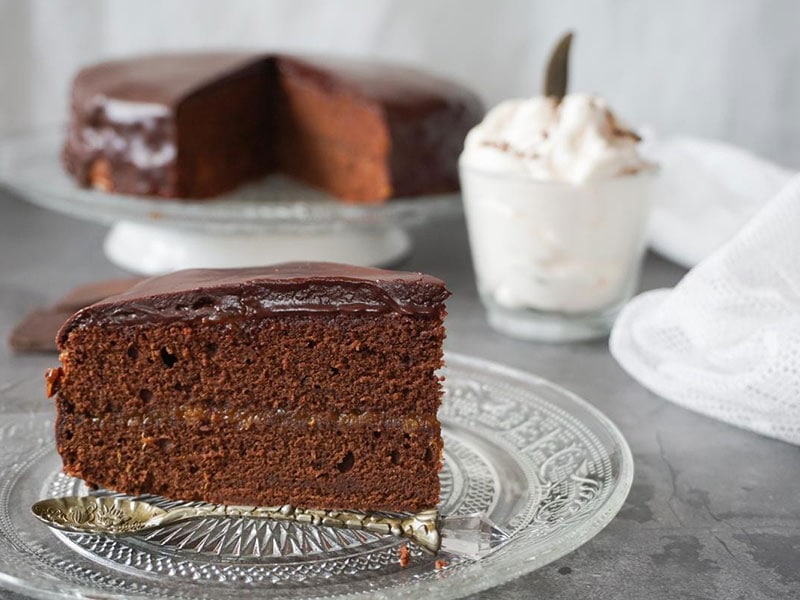
A slice of history with a hint of aristocracy, Sachertorte has its roots in Austria. This renowned dessert traces its lineage back to Franz Sacher, who first created it in 1832 for none other than Prince Metternich of Vienna [3].
Resisting the ordinary, this chocolate torte breaks from the conventional sponge cake mould with its dense and fudgy persona. Layering on the charm, it wields one or more tiers of jam, apricot being the preferred choice.
The crowning glory? A glossy coat of chocolate glaze that tastefully adorns its exterior. The true charm of the Sachertorte, however, lies in its perfect companionship with a little cloud of unsweetened whipped cream on the side.
Each spoonful is a waltz of flavors – moist, dense, and fudgy cake against the light, airy cream.
Hungary
23. Goulash (Stew)
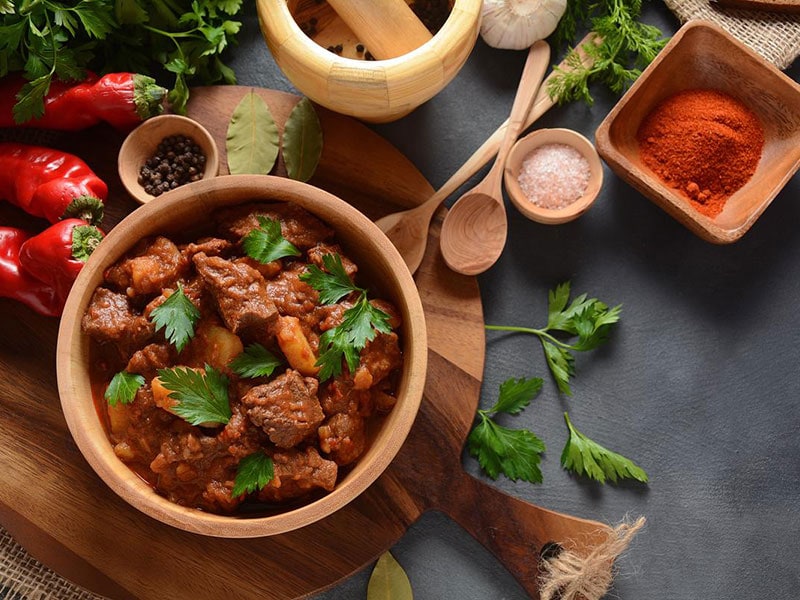
In the heart of Hungary, a national dish named Goulash reigns supreme. This stew, steeped in the rich heritage, is a flavorful medley of meat and vegetables, beautifully harmonized with paprika and a blend of other spices.
Drawing its name from ‘gulyás’ – Hungarian for ‘herdsman’ – it encapsulates the spirit of the countryside, harking back to the 10th-century stews of Hungarian shepherds. Every time I prepare a pot of Goulash in my kitchen, I marvel at the versatility of the meat choices.
Be it beef, veal, pork, or lamb, the collagen-rich cuts such as the shank, shin, or shoulder elevate the dish with a thick and satisfying consistency once cooked. The flavors are further amplified with the inclusion of garlic, caraway seed, carrot, parsley root, peppers, thyme, and bay leaf.
If I want a thicker consistency, diced potatoes become my go-to addition, while a dash of white wine near the end of cooking adds a touch of elegance. Beyond Hungary, I’ve tasted variations of Goulash in Central Europe, Serbia, and Transylvania.
It’s interesting to note the nuances of each region, with the Serbian version, for instance, forgoing vegetables.
24. Lángos (Fried bread)
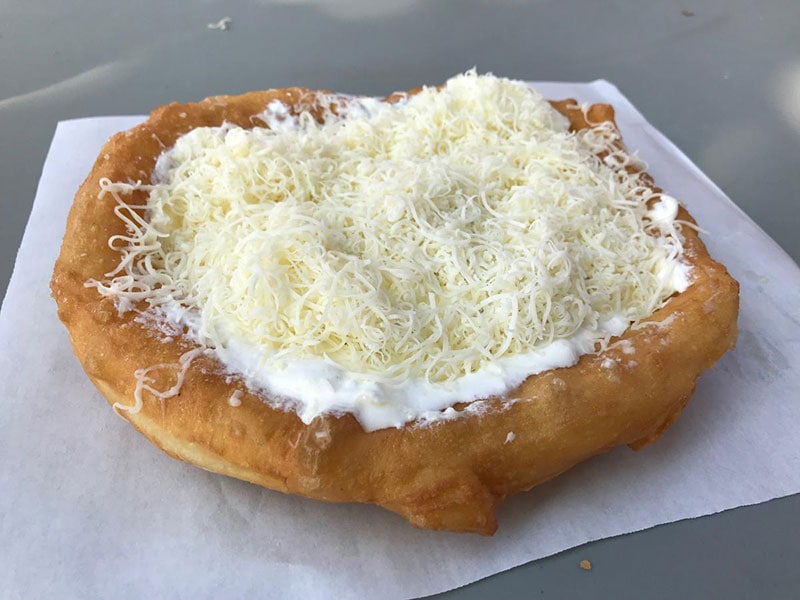
A dish that perfectly embodies the Hungarian culinary world is Lángos, a deep-fried flatbread whose name translates to ‘flame’ in English. The origins of this bread date back to humble beginnings, when it was baked from leftover dough at the front of the brick or clay oven.
Now, whenever I walk around Hungary, I see vendors with street carts offering this ubiquitous treat at bus stations, local markets, fairs, and even sporting events.
With a nostalgia-laden grin, there were only 3 varieties of Lángos in the early ’80s: plain, optionally seasoned with garlic and salt, and those with cabbage or potato kneaded into the dough.
Later that decade, new flavors entered the scene, with sour cream and grated cheese adding a new twist to the traditional recipe. Interestingly, Hungary isn’t the only place where I’ve relished Lángos.
In Austria, and especially Vienna, it’s a celebrated fast food at fairs and amusement parks. Poland and the UK have also embraced this Hungarian classic, calling it ‘langosz’ and ‘langos’ or “Hungarian Fried Bread” respectively.
25. Somlói Galuska (Trifle)
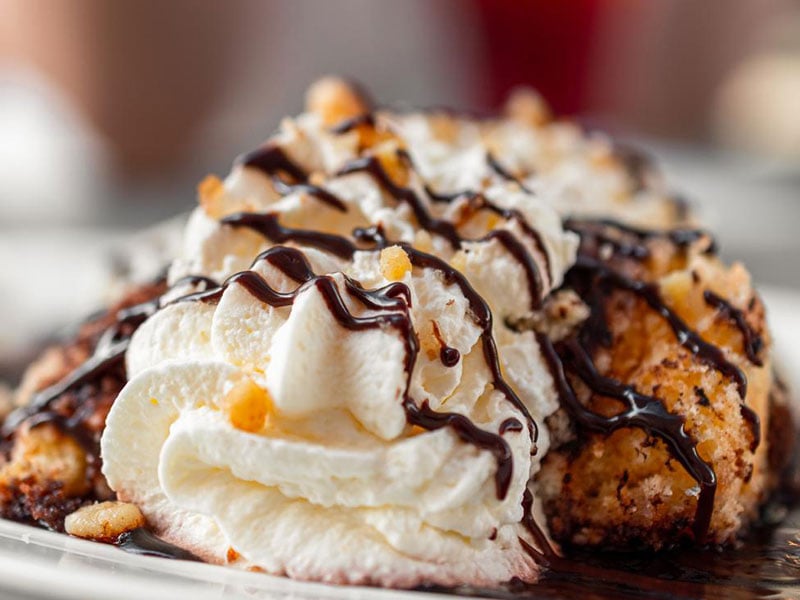
Somlói Galuska, though the name hints at dumplings, is a multi-layered trifle cake that serves as a delectable dessert of Hungarian cuisine.
Picture this: various layers of soft sponge interwoven with custard cream, each slice brimming with raisins that have soaked up either rum or the sweet Tokaji Aszú wine, and a crowning touch of whipped cream.
It all started back in the 1950s, created by Károly Gollerits and József Béla Szőcs from the renowned Gundel restaurant in Budapest. Their innovative dessert didn’t just win the hearts of Hungarian foodies but also secured an award at the Brussels World’s Fair of 1958.
Over time, despite various modern renditions, the original Somlói Galuska still retains its position as one of the finest desserts in Hungary.
26. Dobos Torte (Layered cake)
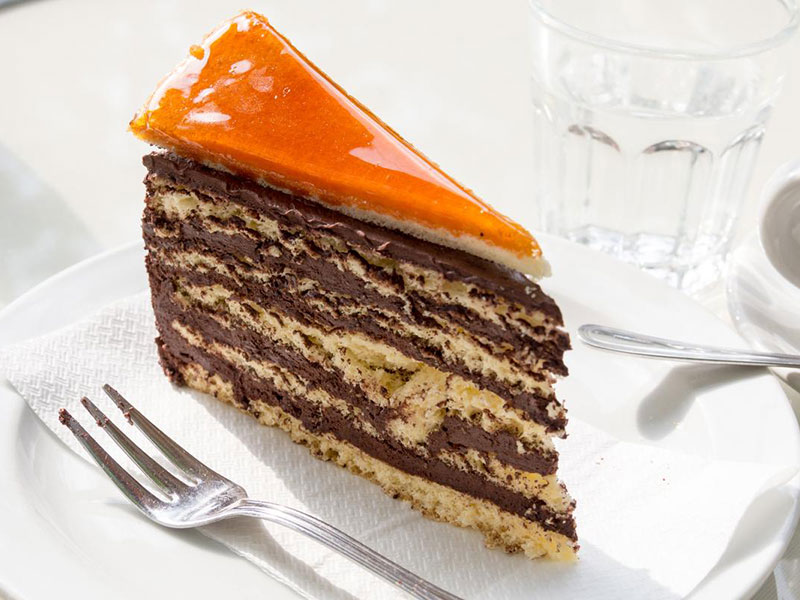
Named after its inventive creator, Hungarian chef József C. Dobos, Dobos Torte or Dobosh, brings together a wonderful array of flavors and textures. Layer upon layer of sponge cake is interspersed with smooth chocolate buttercream, culminating in a shiny caramel glaze atop that serves more than just an aesthetic purpose.
This flat, hard caramel layer, a simple yet elegant detail, safeguards the cake from drying out, thereby extending its shelf life – a clever solution from the late 1800s when cooling techniques were scarce.
Meanwhile, the round sides are coated with a selection of ground hazelnuts, chestnuts, walnuts, or almonds for an added crunch. One cannot forget the cocoa butter, a key player, ensuring that every bite of this dessert has extra smoothness.
27. Pörkölt (Hungarian Meat Stew)
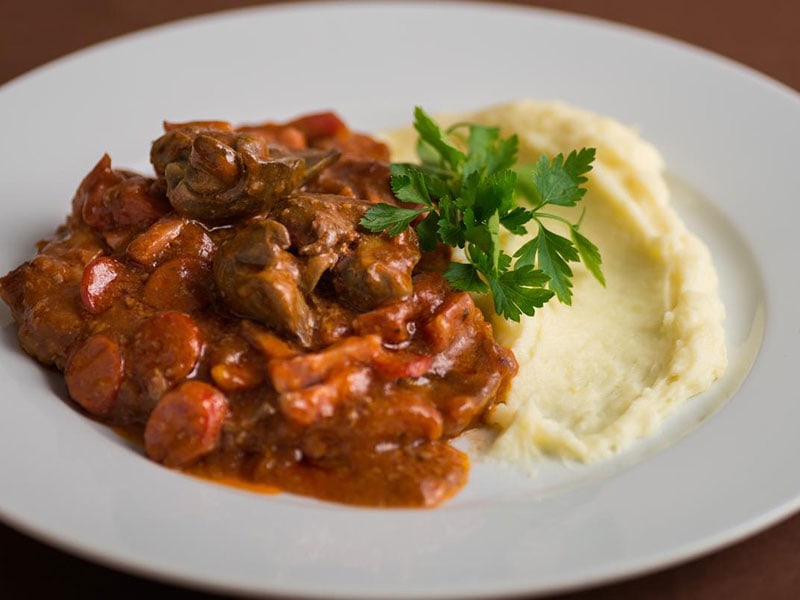
Pörkölt, a hearty meat stew with roots in Hungary, is a culinary masterpiece relished not just in its homeland but all across Central Europe. This dish gets its name from the Hungarian term ‘pörkölni,’ indicative of the roasting or singeing process.
Pörkölt showcases a medley of boneless meat, paprika, and select vegetables. Its companions of choice range from pasta, and dumplings to boiled potatoes. Many also enjoy this stew with a side of Hungarian fruit brandy.
It offers an assortment of flavors in its many versions like marhapölkört (beef), pacalpörkölt (tripe), and borjupörkölt (veal). However, not to be mistaken for gulyás, another Hungarian dish that is soupier and has more gravy.
Alongside paprikás and gulyás, Pörkölt stands proudly as one of the national dishes of Hungary.
28. Chicken Paprikash / Paprikás Csirke/ Csirkepaprikás
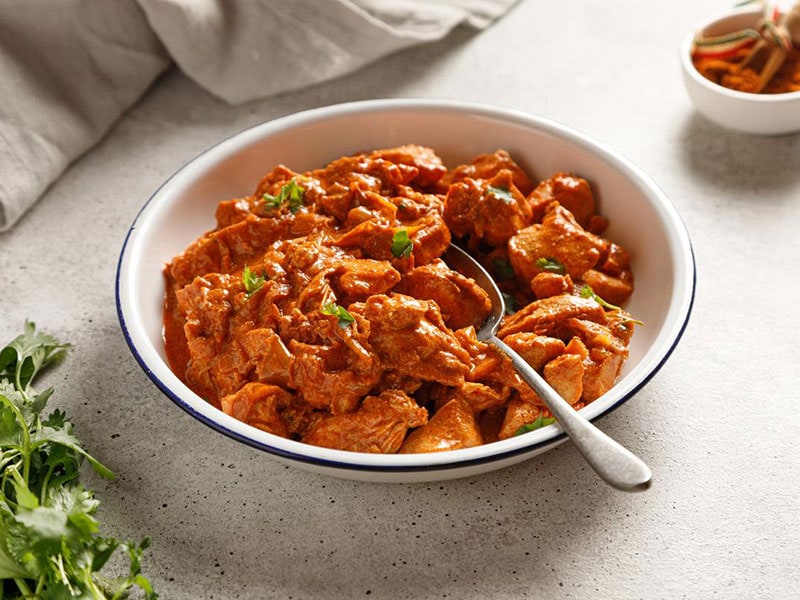
Chicken Paprikash is also known as Paprikás csirke or Csirkepaprikás. As the name suggests, paprika plays a central role in this recipe, embodying the soul of Hungarian cuisine.
This dish basks in the richness of a sauce that starts with a roux, generously infused with paprika, and embraces the chicken, which is carefully simmered to perfection. The result is a richly flavored, creamy concoction that is satisfying.
For the complete Paprikash experience, it’s paired with nokedli, Hungary’s answer to dumplings. Other popular accompaniments include tagliatelle, rice, or millet, each lending a perfect texture to complement this paprika and sour cream-laden delight.
29. Hortobágyi Palacsinta (Hungarian Stuffed Crepes)
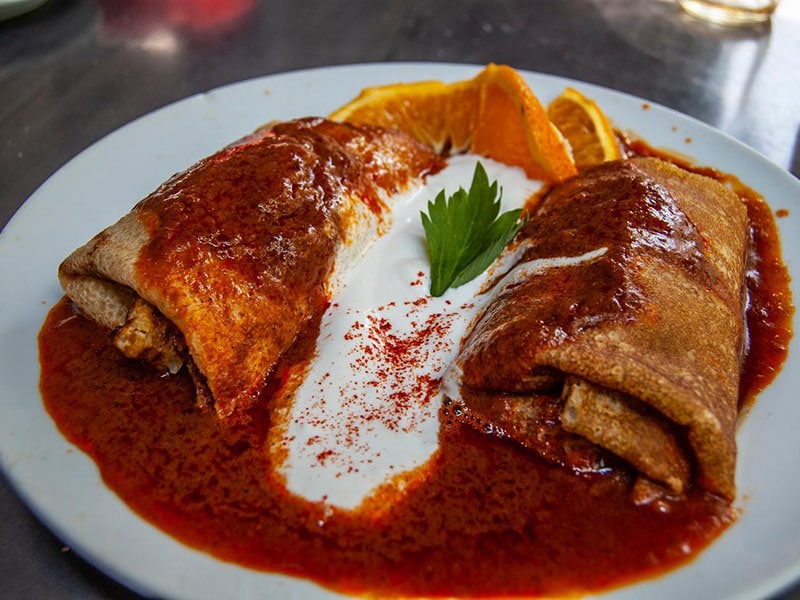
Hortobágyi Palacsinta, Hungarian Stuffed Crepes, takes a savory turn on the classic sweet crêpe. This dish made its debut at the 1958 Brussels World Fair. Despite its name, it doesn’t have a specific tie to the Hortobágy region or the Great Hungarian Plain; rather, it’s enjoyed nationwide.
These crêpes are generously filled with succulent meat, veal being a favored choice. They are then carefully wrapped, ensuring every bite has an equal part of the filling and crêpe.
The real intrigue lies in the next step when these stuffed crêpes are baked in the oven with a luscious sauce made from paprika and tejföl, a type of Hungarian sour cream, giving it a rich, creamy character.
Topped off with fresh parsley for a hint of freshness, they can either be rolled or folded and then rolled again, for a tidy, mouthwatering package.
German
30. Pumpernickel (Dark Brown Rye Bread)
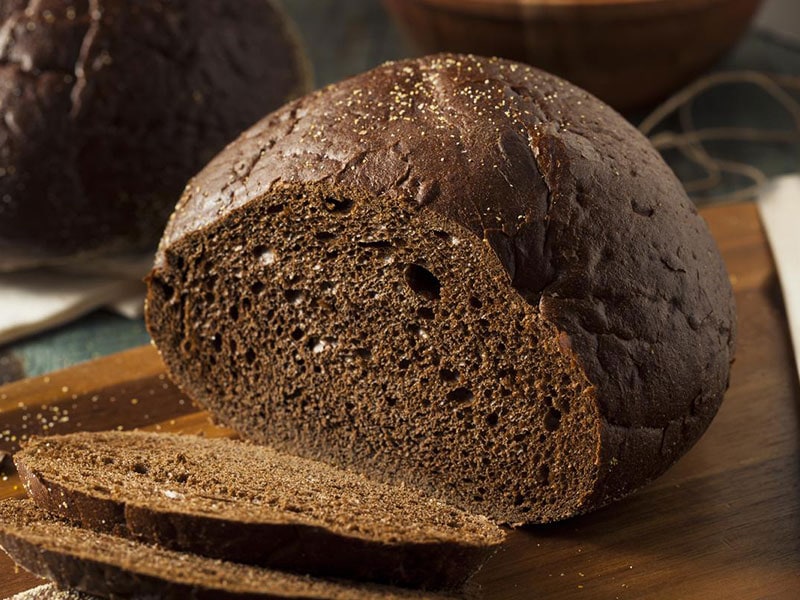
Pumpernickel, this dark brown rye bread, has become one of my go-to bakery items. A mix of a sourdough starter, coarsely ground rye, and whole rye berries go into its making, without any artificial coloring agents.
The distinct deep brown color is thanks to the Maillard reaction, a chemical reaction between amino acids and reducing sugars that gives browned foods their desirable flavor. You’re treated to a sweet, almost chocolatey, and earthy flavor with one bite of pumpernickel.
Now, let’s talk about its distinctive name. It combines two German words, ‘pumpern’, meaning to be flatulent, and ‘Nickel’, a male name associated with the devil in New High German vernacular.
The translation of “devil’s fart” is a quirky addition to its intriguing character. An added perk of Pumpernickel? It’s rich in resistant starch, which is known to aid digestion and benefit blood sugar regulation.
31. Käsespätzle (Cheese Spätzle Pasta)
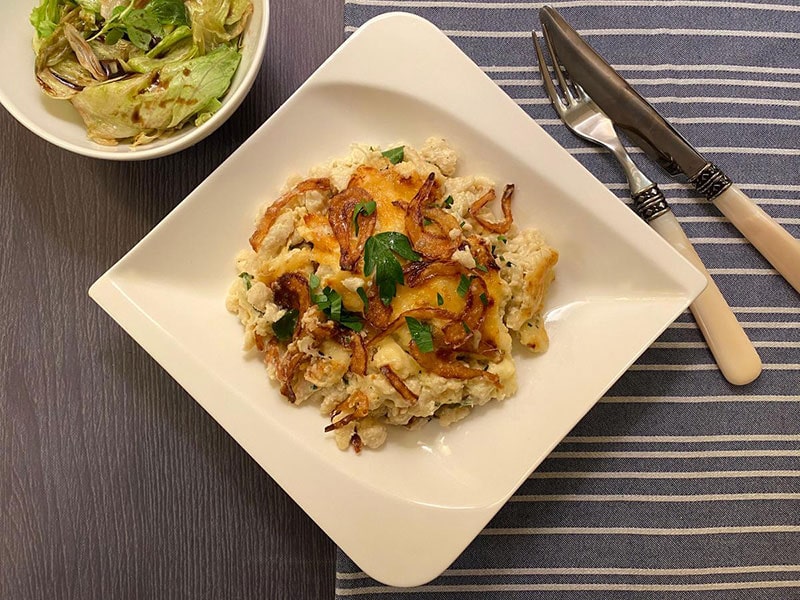
Käsespätzle, known as Käsknöpfle in Liechtenstein, melds spätzle pasta and melted cheese, securing its status as a national dish. It’s a go-to comfort food, particularly prevalent in southern Germany – Swabia, Bavaria, and the Allgäu region hold it dear.
This little pasta, knöpfle, which translates to little buttons, is a gem from Baden-Württemberg. The pasta is made with eggs, wheat flour, and either milk or fizzy water. Seasonings like salt, pepper, and occasionally nutmeg lend it that irresistible flavor.
It’s a compelling mixture of different types of German cheese – Edam, Gouda, Fontina, Gruyère, Appenzeller, or Emmental cheese – all melting together in creamy harmony. The dough is pushed directly into boiling salted water through a special spoon, sieve, or colander.
Once ready, it’s mixed with the melty cheese. Grated cheese and caramelized onions crown this masterpiece. Whether it’s with applesauce, potato salad, or a fresh green salad, every serving is a joy. And trust me, having this at a beer garden in summer or a Munich pub in winter is just unmatched!
32. Schweinebraten (German Pork Roast)
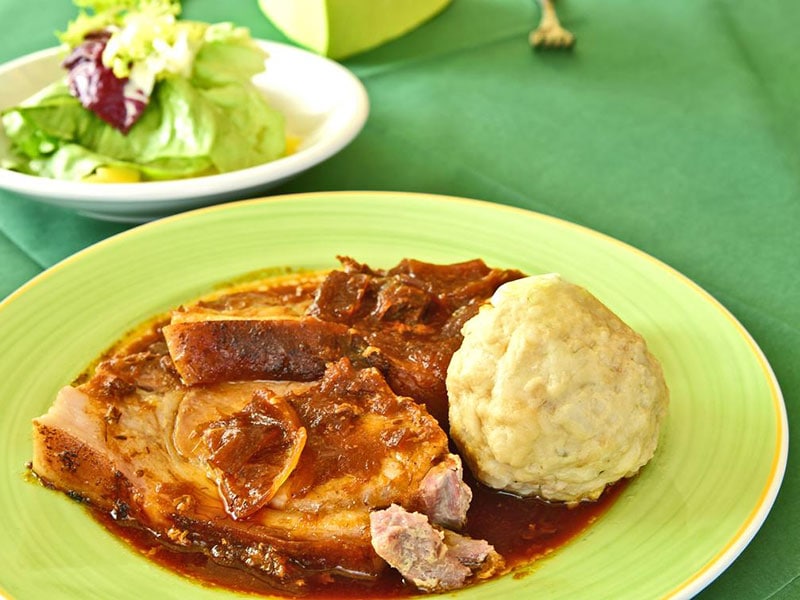
Schweinebraten is a traditional German pork dish that holds a dear spot in my heart. It’s a pork roast, often served as a Sunday lunch, that brings warmth and cheer to the table. The centerpiece is a slice of pork roast, drizzled generously with homemade gravy that simply enhances the flavor.
Now, let’s talk about the accompaniments. Nothing beats Semmelknödel – these bread dumplings, or their cousin Knoedel – potato dumplings, harmonize beautifully with sauerkraut or Rotkohl (red cabbage).
The star of this dish, the pork, is ideally a boneless pork shoulder rubbed with mustard, marjoram, or minced garlic for that extra punch.
As someone who has relished it in beer halls, I can vouch for its place there. And the perfect finishing touch? An ice-cold pilsner! Enjoying a Schweinebraten with a pilsner is, as far as I’m concerned, one of the finer things in life!
33. Rouladen (Beef Rolls)
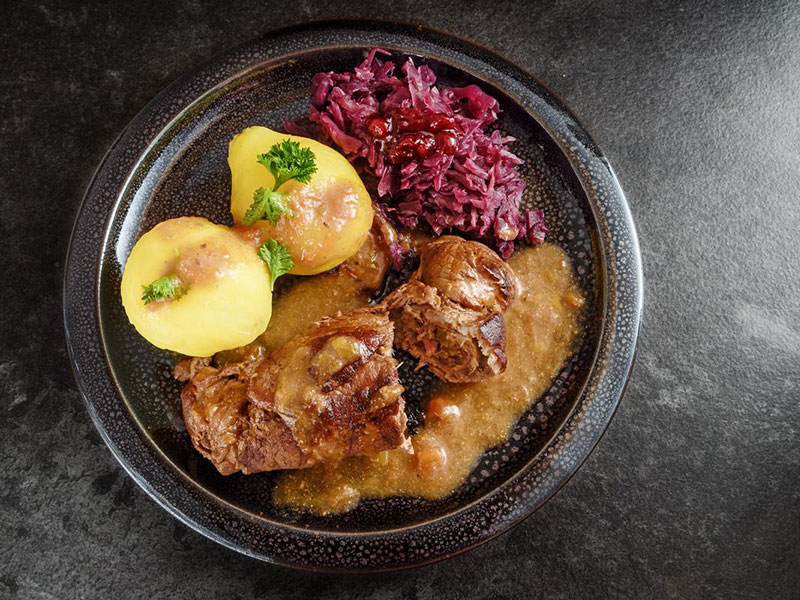
Rouladen, tasty German meat rolls, brim with an assortment of fillings, which pair harmoniously with the delectable beef or vegetable gravy made with a touch of red wine.
I fondly remember my first encounter with these succulent rolls – long, thin strips of beef or veal steaks, pounded to perfection, seasoned and lavished with a layer of tangy German mustard.
These were rolled into small logs and neatly secured with toothpicks. Inside each roll, traditional fillings like thin bacon strips and sliced pickles were tucked away, a surprise waiting for the lucky diner.
Some regional variations also include carrots, onion, or bread as stuffings. Paired with mashed potatoes, potato dumplings, or Blaukraut (pickled red cabbage), these rolls simply melt in the mouth.
Not just Germany, Rouladen is cherished in Poland and the Czech Republic too, known as rolada Śląska and Španělský ptáček, respectively.
34. Currywurst (Curry Sausage)
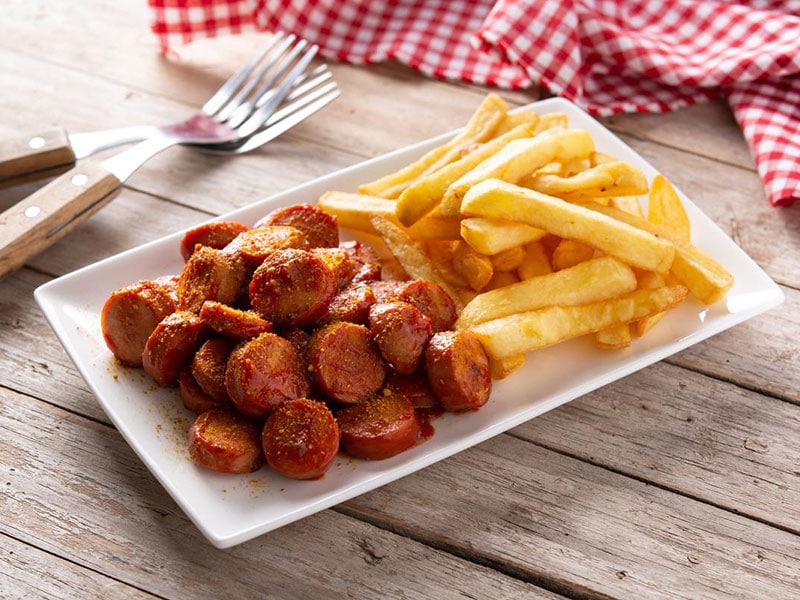
In the bustling streets of Germany, particularly in Berlin and Hamburg, Currywurst holds a special place in the hearts of locals and visitors alike. Back in 1949, this unique German street food was born in the Berlin suburb of Charlottenburg.
The star of the dish, a German bratwurst (a famous German sausage variety), is first boiled and then either shallow fried or grilled. It’s then served whole or in inviting slices. The golden touch? A light dusting of yellow curry powder.
But it’s the smooth, rich curry-spiced tomato sauce that makes this snack unforgettable – a blend of puréed tomatoes and curry powder that just hits the right spots. As for the sides, you have your choice between crispy French fries or a hearty Kaiser roll.
Fun fact: Germans consume a staggering 800 million Currywursts every year, which speaks volumes about their popularity [4]! The Currywurst even has its own museum in Berlin.
35. Weisswurst (White Sausage)
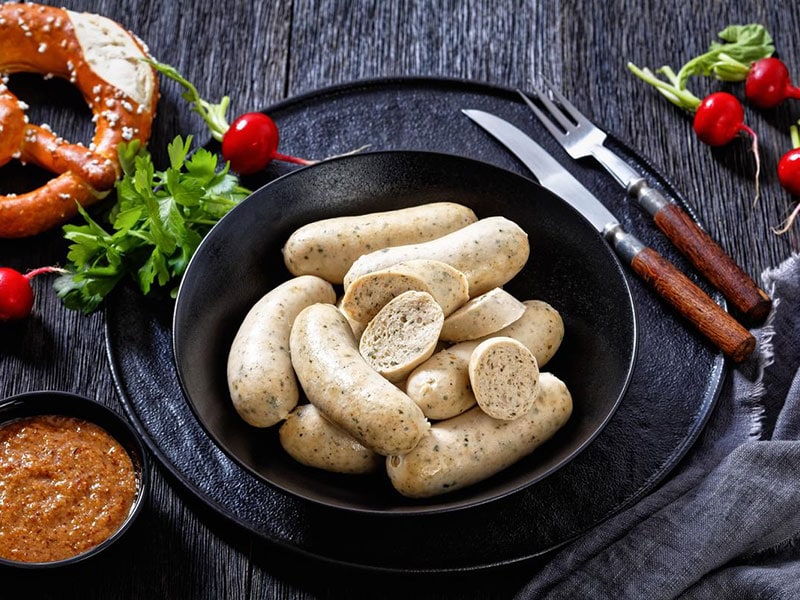
When strolling around Munich, particularly in the Bavaria region, one cannot miss Weisswurst. This traditional bacon sausage is a city specialty that holds quite a history. Its story began in 1857, skillfully created by a butcher named Sepp Moser.
A tempting mix of minced pork back, bacon, and veal makes up this sausage, with a distinctive seasoning of parsley, ginger, mace, cardamon, onions, and a hint of lemon. The secret to its tender texture? It’s delicately cooked in relatively hot water for about ten minutes, avoiding boiling to keep its casing intact.
Unlike many sausage types, Weisswurst isn’t smoked or preserved, which gives it its fresh flavor. This particular sausage holds a time-honored spot as a breakfast or mid-morning snack, with a tradition of savoring it no later than lunchtime.
Picture a German breakfast meal with Weisswurst, pretzels, Bavarian sweet mustard, and perhaps a glass of beer – now that’s a meal worth waking up for! Despite their rich filling, these sausages are generally small, measuring about 4.7 inches long and 1.2 – 1.6 cm thick, making them the perfect bite-size snack.
36. Leberkäse (Liver Cheese)
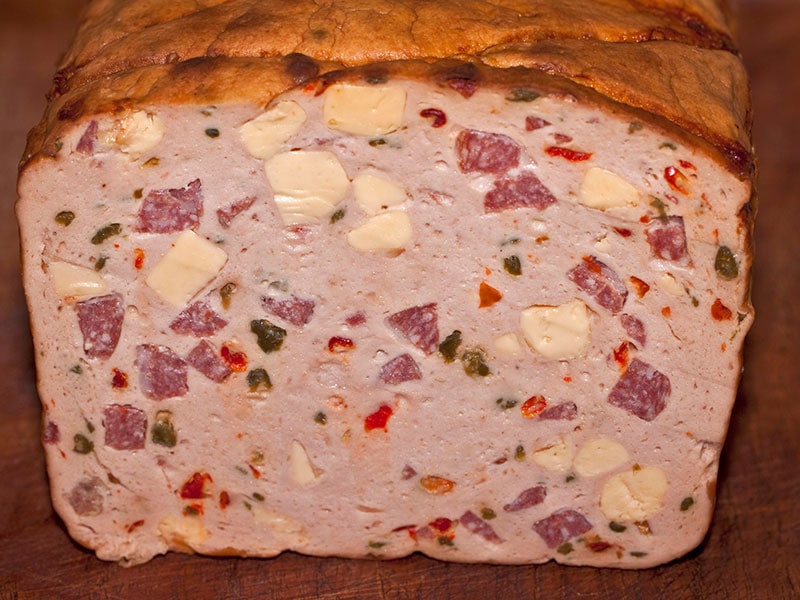
Leberkäse, hailing from Bavaria, has been a staple since a creative butcher whipped up the first batch back in 1776. Ground meat, often pork liver, forms the base, mingled with the rich, warming flavor of onions.
After careful baking, it takes on the form of a hearty meatloaf, boasting a desirable crispy crust, while the interior stays enticingly juicy and pink. Served simply, it pairs beautifully with mustard and bread for a quick snack or light meal.
For those looking for a more filling option, a pan-fried Leberkäse slice can be upgraded to a main dish, accented with fried eggs and potato salad.
Or it can play the role of a cold appetizer, enhanced by the tangy crunch of pickled cucumbers. It’s a beloved choice in southern Germany, where variations might include salted beef or additional pork and onions.
37. Sauerbraten (Sour Roast Meat)
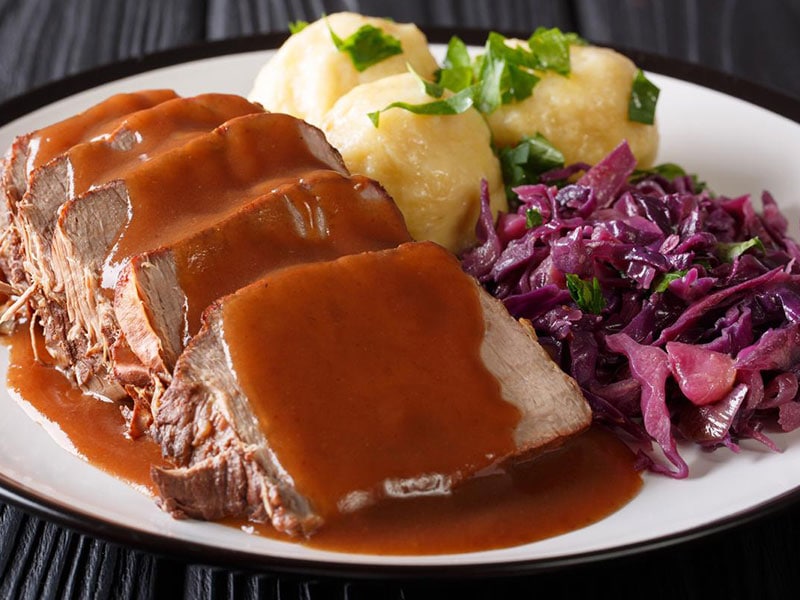
This traditional German pot roast holds a beloved spot in the rich tapestry of Germany’s culinary culture. It used to be made with horse meat, but now, more familiar options like beef, pork, veal, and venison are the norm.
The meat goes through a lengthy marinade process, getting bathed in red wine, tart vinegar, and an array of spices. This allows the meat to become tender and imbued with an incredible flavor.
Once marinated, the meat undergoes slow, patient braising. After the meat is ready, the remaining cooking liquid takes on a new role. Transformed into a thick, brown gravy, it gets seasoned with raisins, sugar beet syrup, apple sauce, and sauce-thickening elements like gingerbread cakes or rye bread.
The beauty of Sauerbraten lies in its regional variations. For example, in the regions closer to France, they lean towards red wine for the marinade. Conversely, in Eastern Germany, closer to the Czech Republic and Poland, vinegar is the choice.
The Rhine region brings its unique touch by adding beetroot syrup and raisins to the mix. Regional twists also extend to Franconia, Thuringia, Saarland, Silesia, and Swabia, each presenting its rendition of this dish.
To complete the meal, Sauerbraten is served with sides like spätzle pasta, bread dumplings, boiled potatoes, and braised or roasted red cabbage. For me, Sauerbraten is more than just a dish. It’s a Sunday family dinner tradition, a culinary story of Germany’s diverse regions.
38. Stollen (German Christmas Bread)
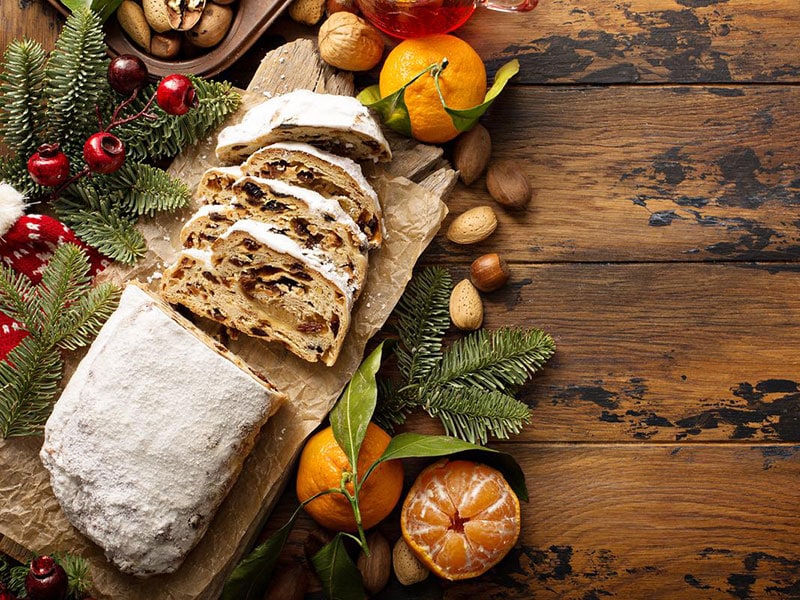
With the arrival of Christmas, one can’t help but anticipate the festive fragrance of Stollen wafting from German kitchens. Originally named “Striezel,” Stollen is a delectable fruit bread, distinguished by its spiced loaf cake form.
Inside its buttery and sweet yeast dough, you can anticipate a festive medley of flavors – from the tang of lemon to the richness of raisins, dried and candied fruits, marzipan, poppy seeds, and nuts.
Once baked, the bread is brushed with melted butter and generously dusted with powdered sugar, a detail that only amplifies its allure. Around Christmas, this bread becomes a yuletide staple in many homes, earning its names – christstollen or weihnachtsstollen.
Pro tip: Stollen gets better with time, so try to wait for about two weeks after baking to savor it at its finest. Among the various versions of Stollen, Dresdner stollen holds a special position.
Known as the oldest and most popular variation, its charm lies in a higher proportion of raisins in the dough, a fact that has earned it EU protection.
Tracing its origins back to 1490, when Pope Innocent VIII lifted the ban on baking with butter during Advent, this special version is most popular in Dresden. Interestingly, its initial recipe only involved flour, yeast, and oil.
39. Sauerkraut (Sour Cabbage)

With roots in China, Sauerkraut is a dish that traveled across continents before adopting its German identity. It started as shredded cabbage fermented in rice wine, making its way to Europe courtesy of Genghis Khan’s expeditions.
In Germany, wine was replaced with salt, and this sour fermented cabbage emerged as a beloved side for meat dishes like Schweinebraten and Bratwurst. It’s not just confined to being a side, though.
From casseroles to sandwiches, Sauerkraut finds a cozy spot in various culinary creations. It’s this adaptability, coupled with a long shelf life, that makes it a popular fixture in German households and beyond.
40. Lebkuchen (German Cookies)
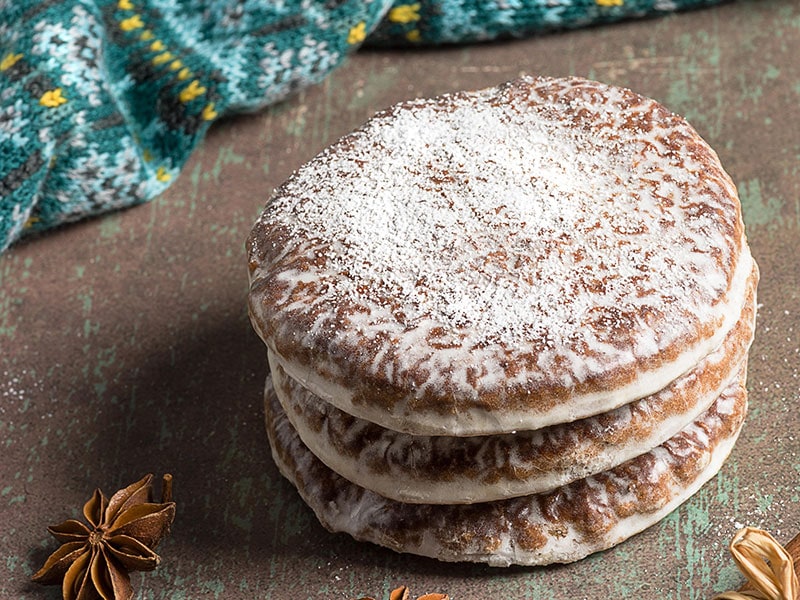
There’s a special place in my heart for Lebkuchen, those honey or ginger-flavored cookies that have a knack for Christmas and warming winter holidays. These cookies resemble gingerbread, sharing a love for warmth and spices.
The traditional preparation involves baking them on thin wafers called oblaten (thin wafers), followed by a glaze of dark chocolate or sugar icing. It’s a melody of flavors, with spices like allspice, aniseed, cardamom, cloves, coriander, ginger, and nutmeg playing their part.
Don’t forget the almonds, walnuts, hazelnuts, and candied fruit that add layers of texture. Among all the varieties, the heart-shaped Lebkuchenherzen, the Honigkuchenpferd (akin to a gingerbread man), and the Hexenhausel (witch’s house) are highly cherished. The Nurnberger Elisenlebkuchen is another fan favorite.
41. Bratwurst Sausage
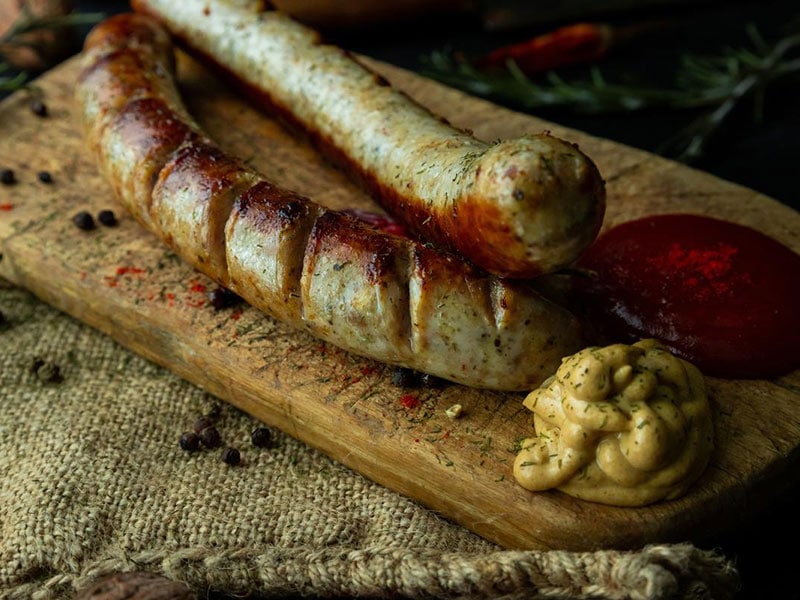
Bratwurst sausage, a famous street food in Germany, is also a staple at any German grill or barbecue. The roots of this food go back to the Celtics, with the Franconians later refining it.
An intriguing fact is that the oldest Bratwurst recipe was unearthed in 2000 by a historian named Heinrich Höllerlhas. The term ‘Bratwurst’ originates in the Old High German word ‘brat’, which signifies meat without waste, and ‘wurst’, denoting sausage.
With over 40 different types, there’s a bratwurst for every palate. Most are crafted from minced pork, veal, or beef and laced with spices such as caraway, coriander, ginger, and nutmeg.
They’re typically fried in a pan or sizzled on the grill and served in a white bread roll, dark rye bread, or wrapped in a pretzel. Many mornings in Germany start with a Bratwurst for breakfast, paired with stewed sauerkraut, potato salad, or condiments like ketchup, horseradish, and mustard.
To complement the meal, a traditional German beer is a must. There’s a special thrill to seeing bratwurst being grilled over sizzling barbecue stands in German streets or at soccer matches. The slightly crispy skin and savory flavor make it truly special.
Outside of Germany, Bratwurst has also gained popularity, particularly in the United States, and is a summer favorite in Wisconsin for cookouts and barbecues.
42. Pretzels
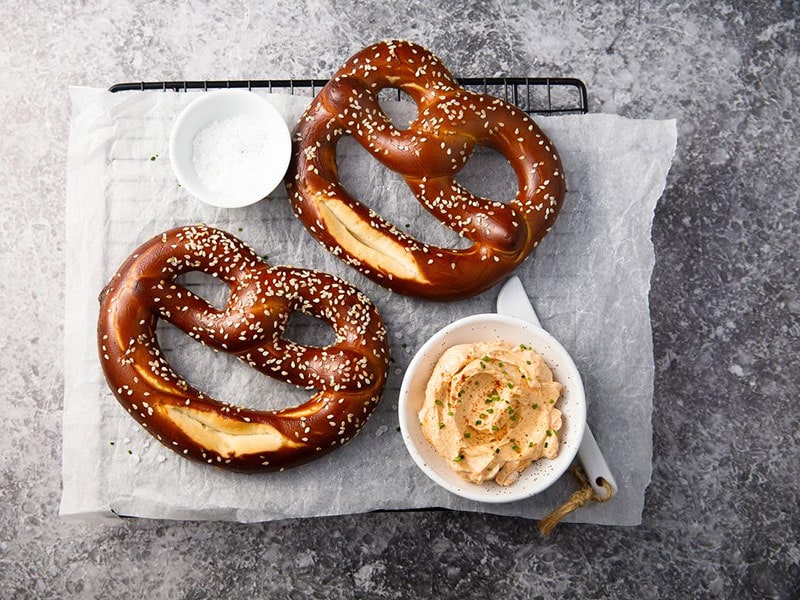
Pretzels, a symbolic representation of Germany, stand out as traditional baked goods known and loved worldwide. Forming these unique treats involves kneading a simple mix of flour, salt, malt, yeast, and water into a knotted shape.
But, the true alchemy happens when the formed dough takes a dip in a lye solution before baking. This notable step results in a beautiful Maillard reaction, transforming the surface into a brown and crispy exterior that has a distinct flavor. Generously seasoned with salt, pretzels can also come adorned with other toppings.
Think mustard, cheeses, seeds, nuts, or even sweet treats like cinnamon, sugar, chocolate, and more. Two main types can satisfy your craving. Soft pretzels, which should be consumed soon after preparation, or hard-baked pretzels, whose longer shelf life guarantees a crunchy bite whenever you want.
Ashkenazi Jews
43. Blintz (Rolled Pancake)
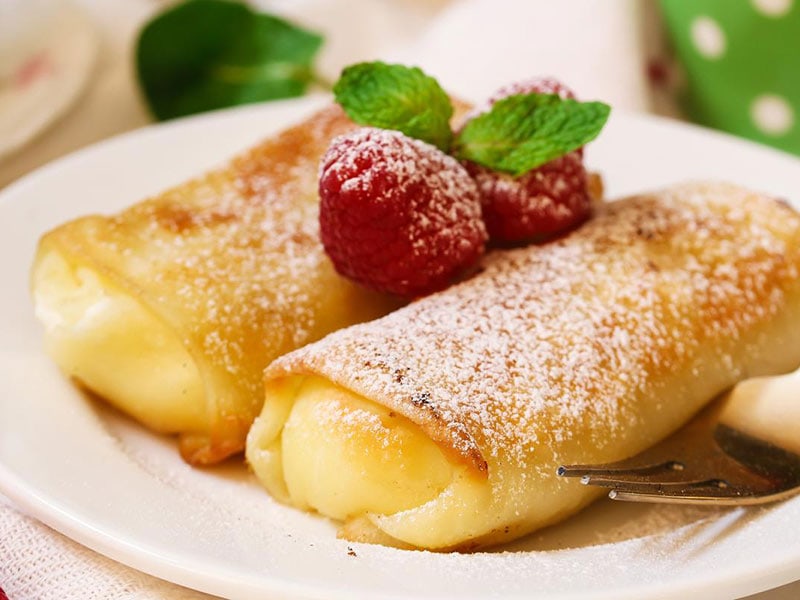
Blintz, the rolled pancake, is a tasty creation made with thin pancakes that closely resemble crepes or blini. The pancakes are filled with a delicious blend of farmer’s or cottage cheese and then pan-fried in butter or cooking oil until they turn a beautiful golden color.
To add a touch of freshness and sweetness, they can be topped with a medley of fruits. Traditionally enjoyed on Shavuot (Feast of Weeks), also known as Pentecost, these blintzes bring a special touch to the festive table. With their delicate texture and mouthwatering flavors, blintzes are a beloved treat.
44. Latke (Potato Pancake)
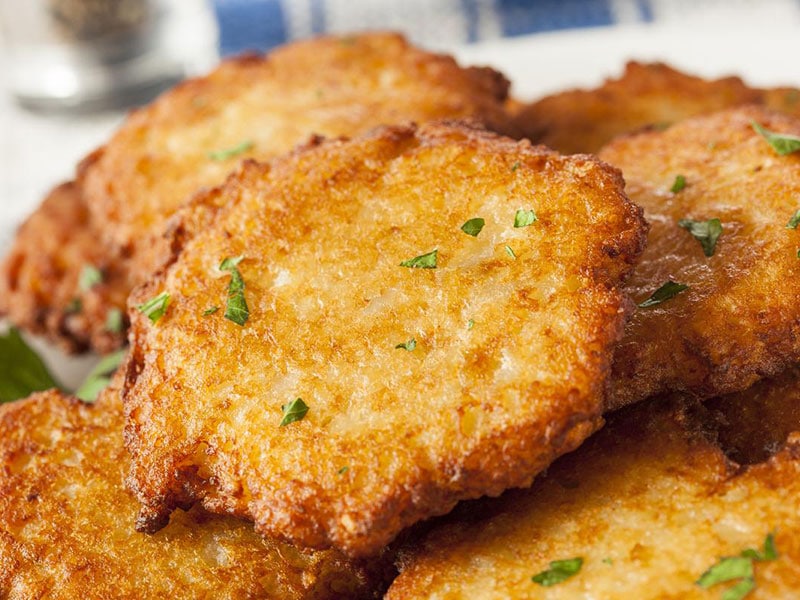
Latke, the potato pancake traditionally made for Hanukkah, combines grated or mashed potatoes (preferably russet), onions, eggs, and salt. The mixture is formed into patties, griddled, and then deep-fried in oil.
These crispy pancakes are best enjoyed hot, with a rich, savory flavor enhanced by the onions. Latkes trace their origins back to the Middle Ages, evolving from cheese pancakes to their current potato-based form.
Notably, the amount of oil used in frying latkes symbolizes the miraculous Hanukkah story. Despite having only enough oil for one day, the menorah’s oil in the re-sanctified Second Temple lasted for eight days though there was only enough oil for one day.
45. Knish (Baked/ Deep-fried Dough With Fillings)
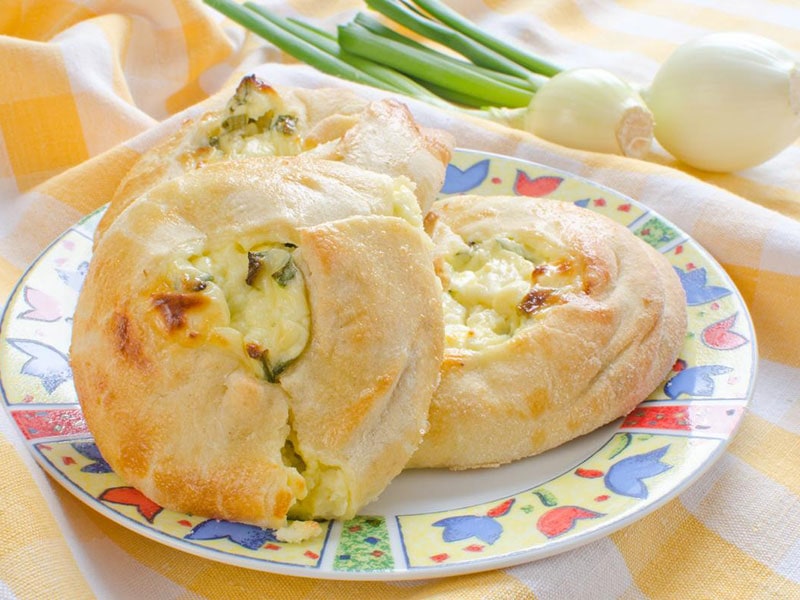
Originally crafted by Ashkenazi Jewish communities within the Pale of Settlement, a region in the western part of the Russian Empire, this street food made its American debut in New York City in the early 20th century, thanks to refugees.
The city’s streets have been a bit tastier since then, with the knish becoming an affordable and beloved fixture. So what’s inside this intriguing dish? You’ll encounter a comforting filling, usually mashed potato or kasha, a type of buckwheat grain.
But, don’t worry, other fillings such as spinach, sauerkraut, onions, cheese, or minced meat are also quite popular. This flavorful stuffing is enveloped in a simple dough, made from just flour and water.
Depending on your preference, the knish can be baked or deep-fried, and is versatile in its shape, being either round or square. Whether it’s a hot day or a cold one, a knish can be savored at any temperature and at any mealtime.
Its adaptability doesn’t stop there – it pairs well with sides and condiments like mustard, sandwiches, and salads.
Switzerland
46. Meringue
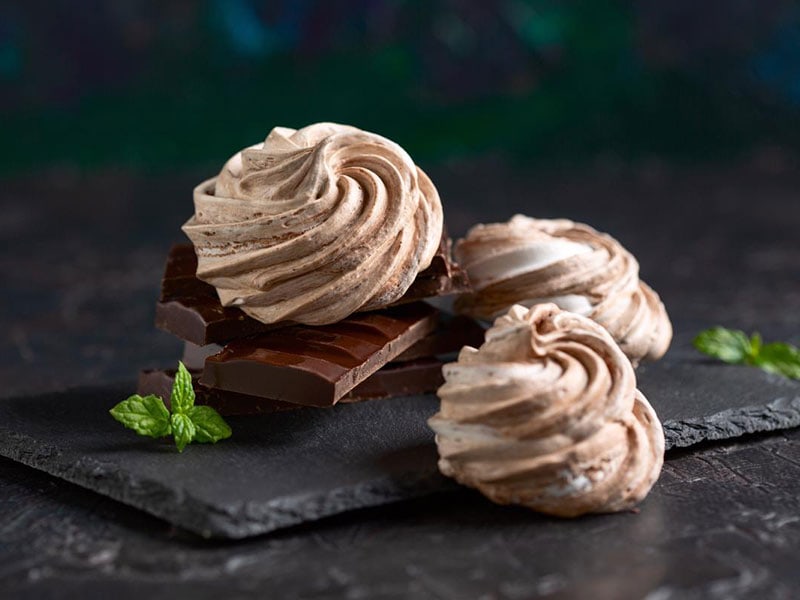
Meringue, a tasty Swiss dessert or candy, is also cherished in French, Italian, and Polish cuisines. This sweet treat is created by whipping egg whites and sugar together to form a fluffy mixture.
Sometimes, a touch of acidity from lemon, vinegar, or cream of tartar is added to enhance the stability of the meringue. Binding agents like salt, flour, or gelatin may also be incorporated.
Swiss meringue, a popular variation, involves warming the egg whites over a bain-marie before baking. The result is a dense and glossy meringue with a marshmallow-like texture.
47. Cordon Bleu
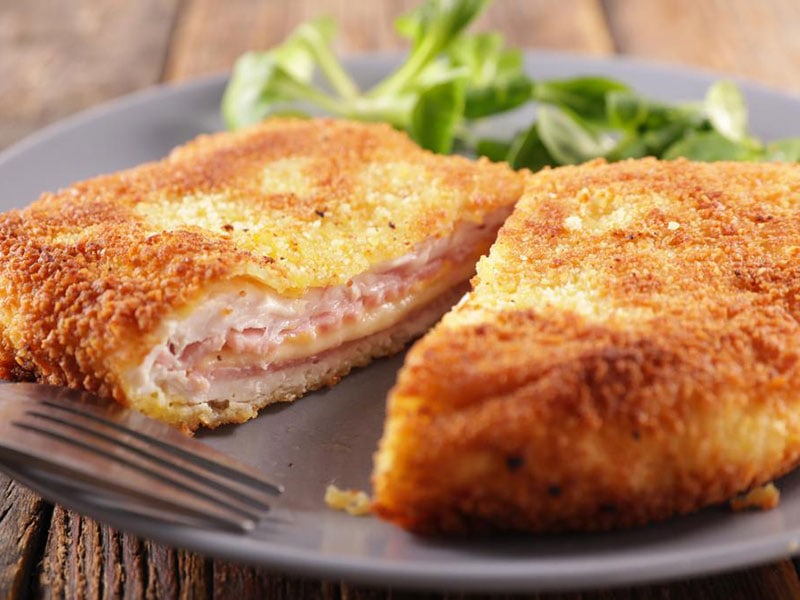
Cordon Bleu is an international dish with Swiss origins. It consists of a meat cutlet, typically veal or chicken breast, filled with a thin slice of ham and cheese, often Gruyère. The cutlet is then breaded and can be prepared by deep-frying in hot oil, shallow frying in a pan, or baking in an oven.
This results in two succulent meat scallops with a delightful ham and cheese filling sandwiched in between. First mentioned in a cookbook from 1949, Cordon Bleu has since gained popularity and evolved into numerous varieties.
It can be enjoyed with different types of meat and even served with a luscious mushroom sauce. As accompaniments, French fries, vegetables, and garnishes like lemon wedges and parsley complement this dish perfectly, adding a burst of flavor and freshness.
48. Fondue
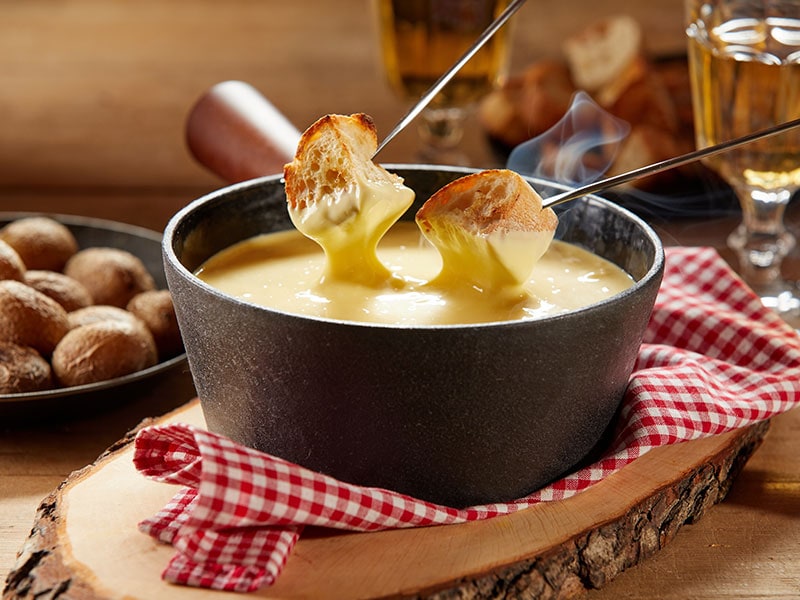
Fondue, derived from the French word ‘fondre’ meaning ‘to melt,’ has its roots traced back to 18th-century Switzerland. This iconic Swiss dish involves melting a blend of different cheeses together, traditionally Emmental and Gruyere, with the addition of white wine, garlic, and cornstarch.
Served in a communal pot known as a ‘caquelon,’ which is placed over a small stove called a ‘réchaud,’ fondue creates a cozy and interactive dining experience. Using long-stemmed forks, diners dip pieces of bread into the melted cheese, savoring the rich and creamy flavors.
Fondue has evolved to include various varieties beyond cheese, such as chocolate fondue for dessert or fondue bourguignonne with meats. In the 1930s, it gained recognition as the Swiss national dish, capturing the hearts and palates of people worldwide [5].
49. Rösti (Swiss Potato Pancakes)
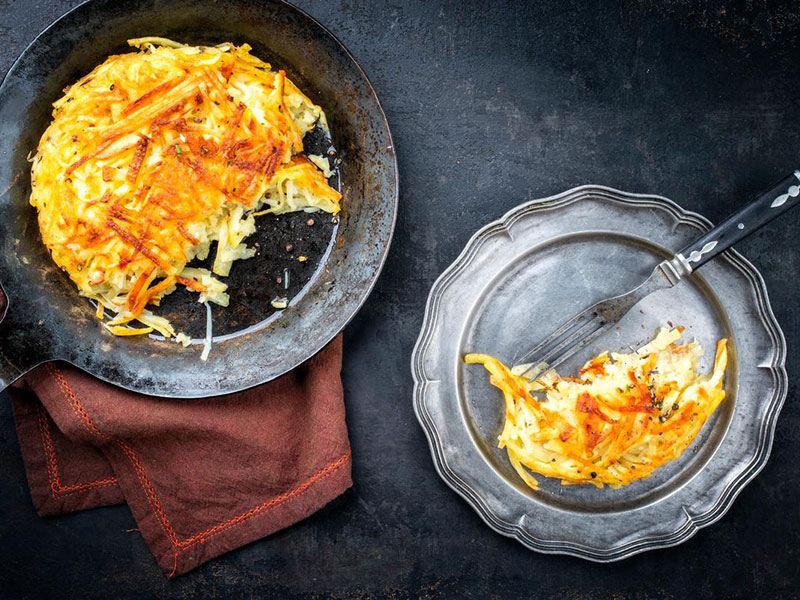
Rösti, known locally as Rööschti, is the Swiss take on the potato pancake. This savory, satisfying dish has its roots in the German-speaking region of Switzerland, more specifically in the canton of Bern.
Here, it is a cornerstone of the farmers’ breakfast, filling and fueling for a long day’s work. In its simplest form, Rösti is created from coarsely grated potatoes formed into a circle, fried until crispy in hot butter or fat.
A handy tip for the perfect crust is cooking the first side covered with a lid or foil, which helps it to crisp up beautifully. Now, if you appreciate a little extra flavor, ingredients like bacon, onion, cheese, and even apples are often incorporated.
Just like a canvas, Rösti is ready for a burst of color and flavor with an assortment of toppings. From raclette cheese to fried eggs, bacon, smoked salmon, onions, spinach, mushrooms, sour cream, and corn – there’s something for every palate.
Traditionally, it’s served alongside gherkins, a meatloaf called fleischkäse, and pickled pearl onions.
50. Raclette Cheese
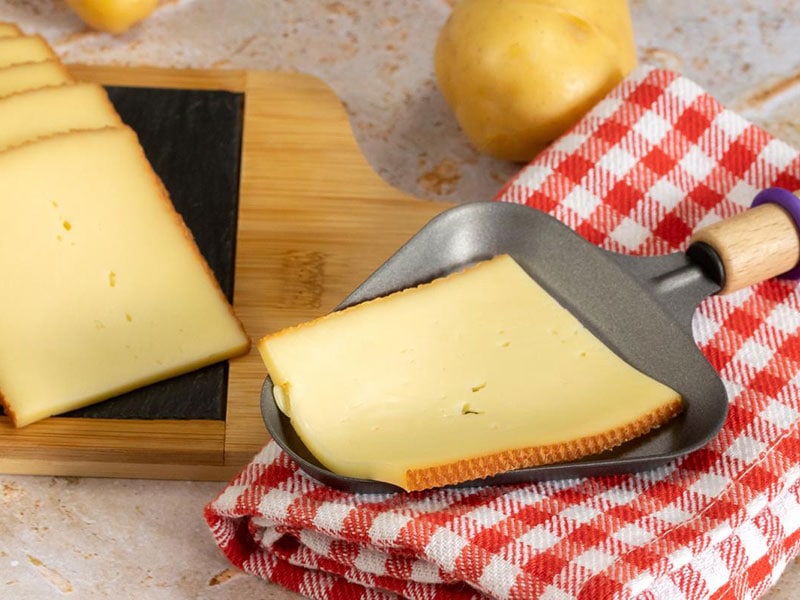
Raclette Cheese, a popular Swiss cheese variety made from Alpine cow’s milk, carries with it a slightly nutty flavor profile that only improves when melted.
Its origins trace back to the Swiss mountain shepherds who invented this cheese, now popular in ski regions like Valais, Geneva, and across the Swiss Alps.
This semi-hard cheese even found fans in Germany and northern Italy. The name Raclette comes from the French word ‘racler,’ which means to scrape, offering a hint to its traditional consumption. These days, modern appliances such as raclette melters and grills take over from the classic fireplace.
Once melted, Raclette cheese becomes a star in culinary delights, typically served with Gschwellti (small potatoes in skin), pickled gherkins, boiled vegetables, cold meats, and bread. The cheese pairs harmoniously with white wine or tea, making it an elegant choice for a variety of meals.
Other
51. Käsknöpfle (Triple Cheese Pasta With Onions) – German, Austria
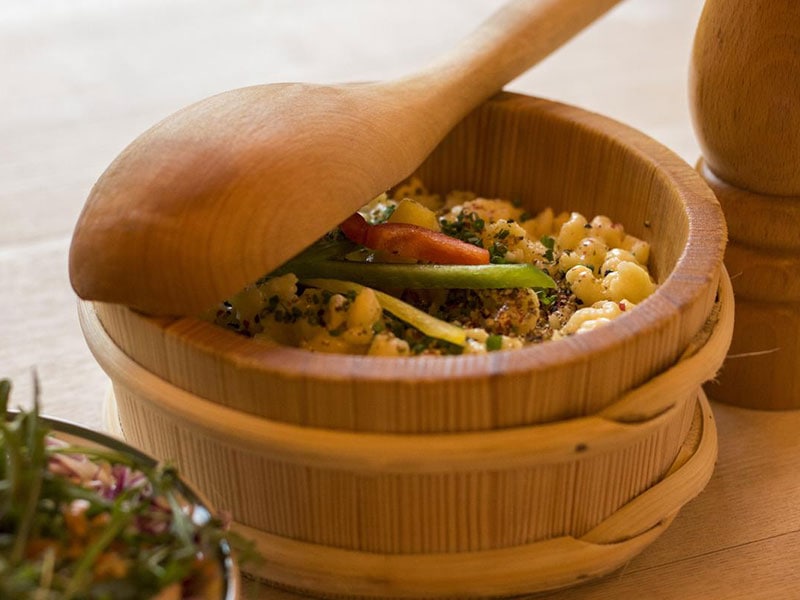
Käsknöpfle is a traditional dish hailing from the German regions of Swabia, Baden, and Allgäu, as well as being enjoyed in Austrian regions like Vorarlberg, Tyrol, Liechtenstein, and Switzerland.
In Tyrol, it is prepared using Bergkäse or Emmental cheese, while in the Bregenz Forest, a combination of Bergkäse and Räßkäse, a local hard cheese, is used. In Vorarlberg, it is typically served with butter and onion rings as accompaniments.
52. Moczka (Christmas Ginger Bread Soup) – Upper Silesia
Moczka, a beloved Silesian dish enjoyed on Christmas Eve, is a gingerbread soup. This traditional delicacy features a blend of gingerbread, almonds, dried apricots, hazelnuts, pears, raisins, dried plums, figs, and dates, all soaked in dark beer.
While modern versions may incorporate fruits and compotes, it doesn’t resemble a vegetable soup with fruit. The specific ingredients used can vary across different parts of Silesia, but gingerbread remains the foundation of this festive dish.
53. Wodzionka (Silesian Bread Soup) – Silesia, Central Poland
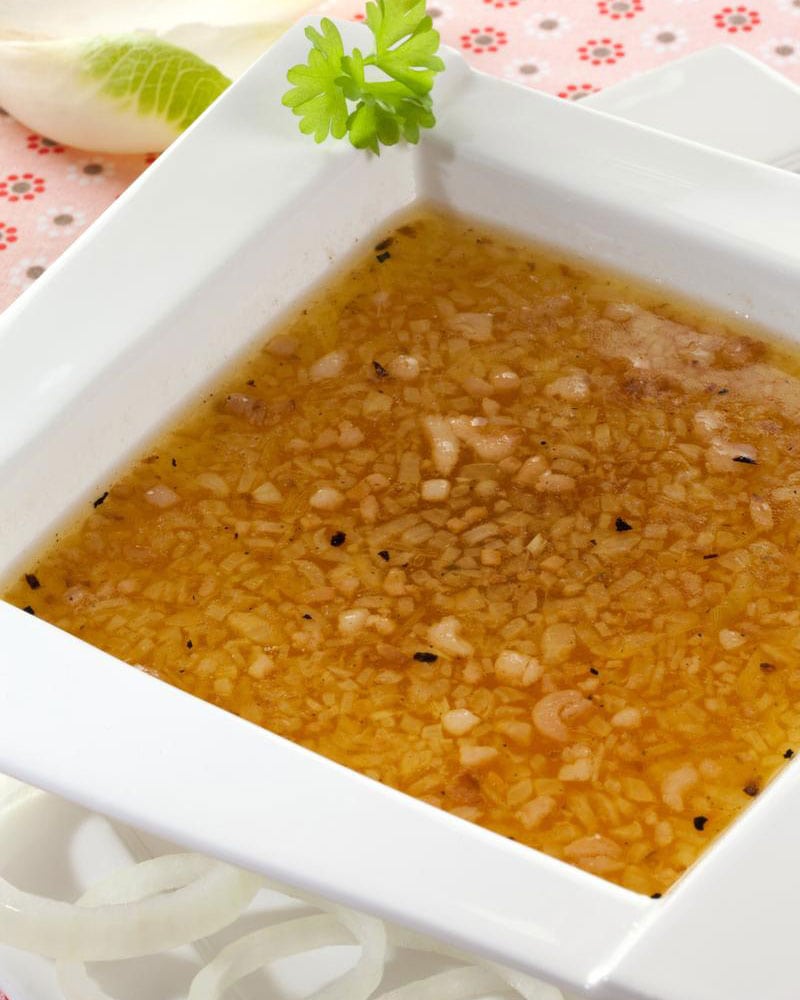
Wodzionka, also known as Wodzianka, kapłonek, or brotzupa, is a traditional bread soup enjoyed in Silesia and Central Poland. This humble dish is crafted using stale bread, fat, and either water or milk.
The process involves soaking two- to three-day-old bread in water or broth to soften it. Seasonings such as fried bacon, lard, butter, bay leaves, garlic, and black pepper are added to enhance the flavors.
Wodzionka showcases the resourcefulness of using leftover bread and simple ingredients to create a satisfying and nourishing soup.
54. Kaiserschmarrn (Austrian Pancakes) – Austria, Germany
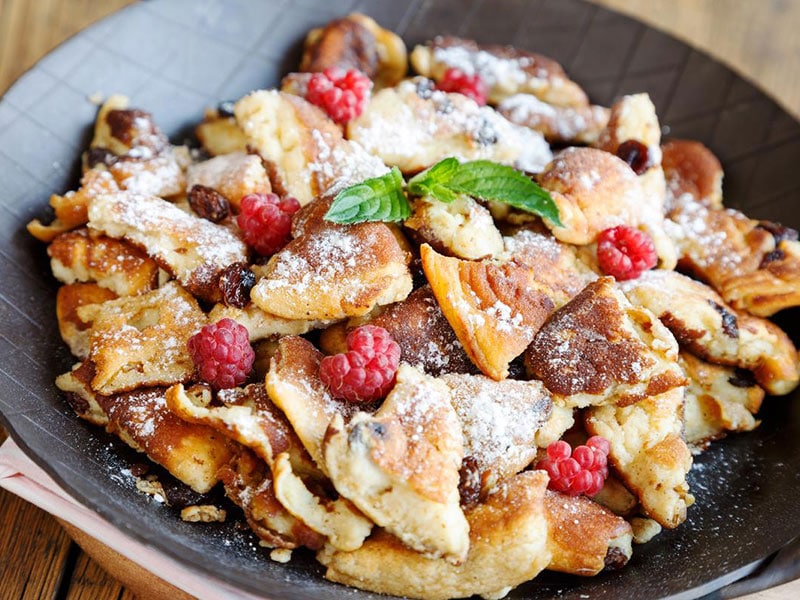
Kaiserschmarrn, a beloved Austrian dessert, is a lightly caramelized, scrambled pancake that holds a special place in culinary history. It was rumored to be the favorite dessert of Emperor Kaiser Franz Joseph I.
Traditionally served with zwetschkenröster (plum compote) or apple, pear, and berry preserves, Kaiserschmarrn is generously dusted with icing sugar, adding a touch of sweetness. It’s the epitome of comfort food, perfect for indulging in on a cozy evening.
Modern variations of Kaiserschmarrn feature different fillings, such as mirabellenschmarrn (mirabelle plums), apfelschmarrn (apples), kirschschmarrn (cherries), sauerrahmschmarrn (sour cream), and nußschmarrn (walnuts, almonds, hazelnuts).
This dessert is not limited to Austria alone; it also finds its place on the dessert menus of Bavaria, a German region. With its caramelized edges and fluffy texture, Kaiserschmarrn delights taste buds and warms hearts.
55. Cremeschnitte (Vanilla Slice) – Central Europe
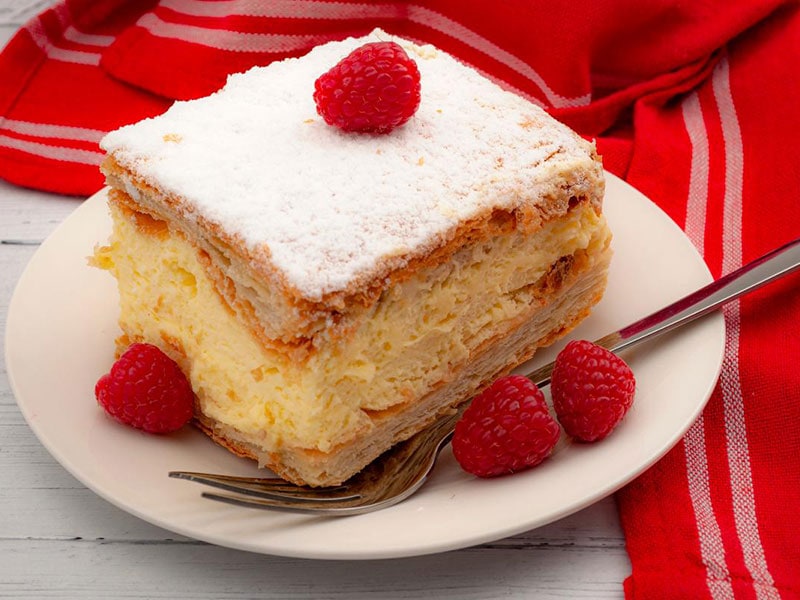
Cremeschnitte, a custard cream cake hailing from Central Europe, is an appetizing dessert with roots in the Austro-Hungarian empire. Its name, derived from German, quite literally means cream slice or cream pie, capturing the essence of this dessert.
Some believe that it originated from the French mille-feuille, another well-known pastry. This heavenly dessert comprises two layers of puff pastry, generously filled with a hefty amount of pastry cream.
A final sprinkle of icing sugar graces the top, with some variations featuring whipped cream or icing. Among its famous varieties, you’ll find the Polish Napoleonka or Kremówka, a preferred dessert of Pope John Paul II, and the Slovenian Kremna Rezina, the signature dessert of Bled.
56. Babka (Sweet Braided Bread) – Central Europe
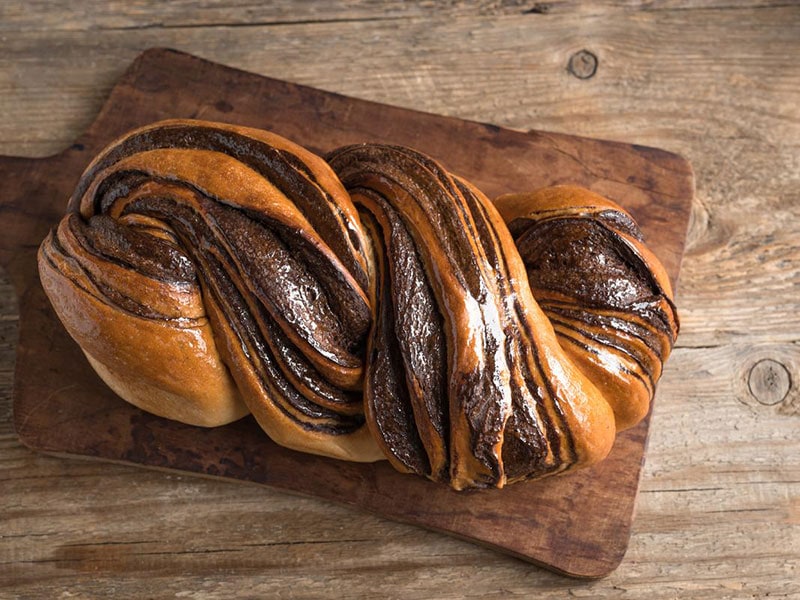
Babka, a sweet braided bread, adorns Easter tables in Poland and other Central European countries, marking it as a cherished holiday tradition. The bread gets its twist from a Bundt mold and its sweet touch from raisins soaked in rum.
A glaze of fruit-based icing brings it all together, with modern versions introducing flavors of vanilla, lemon, or chocolate. Enjoy this tasty bread as an afternoon snack or dessert, paired with hot coffee to enhance the flavor experience.
A Jewish variation, especially well-known in North America, swaps out the fruit filling for a delicious mix of cinnamon and chocolate. The name “Babka” derives from the Polish word for grandmother, inspired by the fluted skirt reminiscent of a grandmother’s wide attire.
The shape also carries a deeper significance, symbolizing fertility. Its origin is shrouded in theories; one proposes it evolved around Easter in Slavic regions, while another suggests it journeyed from Italy to Poland, evolving from the popular Italian panettone.
57. Tafelspitz (Boiled Meat) – Austria, Germany
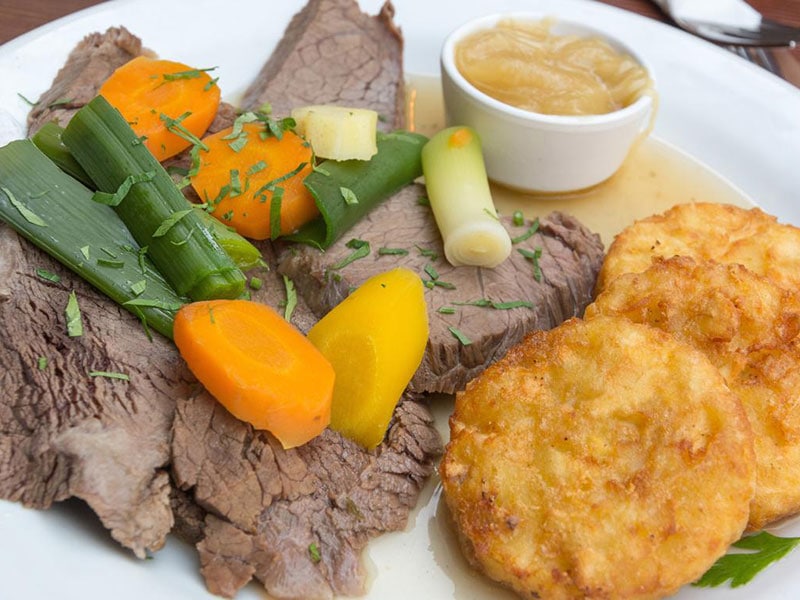
Tafelspitz is an Austrian delicacy, favored even by Emperor Franz Joseph I, as documented in the 1912 imperial cookery book. This traditional dish takes a specific cut of beef, sourced from the top hind end of the cow, just below the tail. Some prefer to use the top round or chuck for an equally sumptuous outcome.
The meat, slow-simmered with root vegetables, sometimes incorporates chicken pieces and a marrow bone for a more complex flavor. The broth is constantly skimmed, ensuring a crystal-cloup that is as pleasing to the eye as it is to the palate.
In traditional servings, the Tafelspitz experience unfolds in separate courses. The first course offers hot broth, served elegantly in bouillon cups. Following this, tender slices of the simmered beef make their appearance, escorted by potatoes, carrots, and a distinctive apple-horseradish and chive sauce.
58. Maultaschen (German Stuffed Pasta) – Germany, Italy
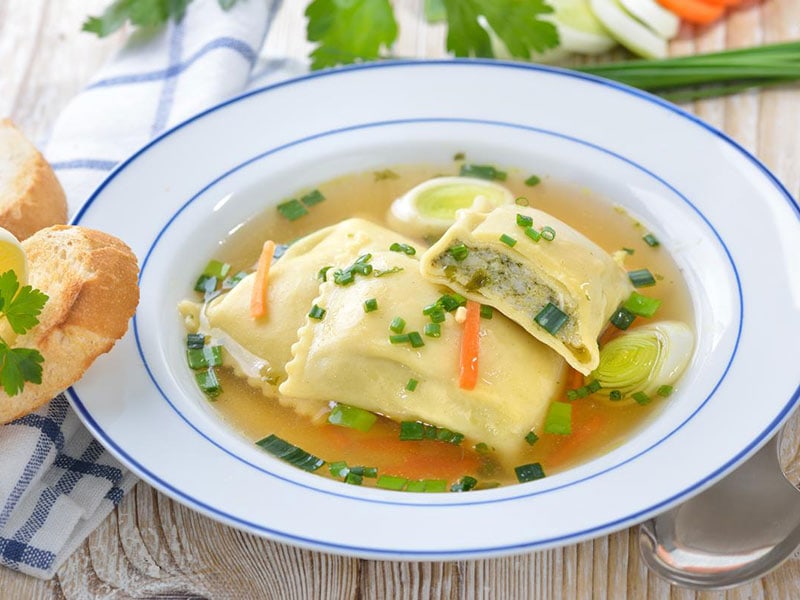
Maultaschen is a star dish in Swabian cuisine, akin to large, meat-filled dumplings. Picture pasta dough generously stuffed with smoked meat, minced meat, bread crumbs, spinach, and onions, all bursting with flavor from a blend of herbs and spices like parsley, pepper, and nutmeg.
Each piece is meticulously crafted, measuring around 3 – 4 ½ inches. Back in October 2009, Maultaschen was granted a ‘Protected Geographical Indication (PGI) by the European Union, a nod to its cultural significance in the region of Baden-Württemberg.
True to its roots, it’s exclusively produced in Swabia, adding a dash of local pride. You can savor Maultaschen in two traditional ways: either simmered in broth and served like a soup, or dressed with onions and butter.
59. Bryndzové Halušky (Potato Dumplings With Cheese) – Slovakia
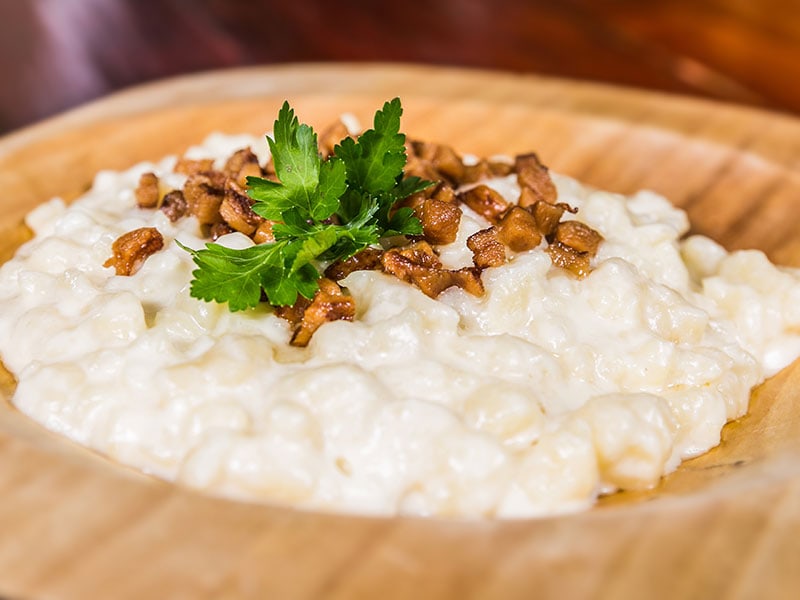
Bryndzové Halušky, a cherished Slovakian comfort food, consists of small potato dumplings that resemble Italian gnocchi, known as halušky. These dumplings are then tossed in a special sheep cheese called bryndza, creating a creamy and tangy coating.
To enhance the flavors, they are typically served with crispy fried onions, savory bacon, and fresh chives. This hearty and satisfying dish encapsulates the essence of Slovakian cuisine, bringing together the humble potato, rich cheese, and savory toppings.
60. Štrukli (Cheese Dumpling) – Slovenia
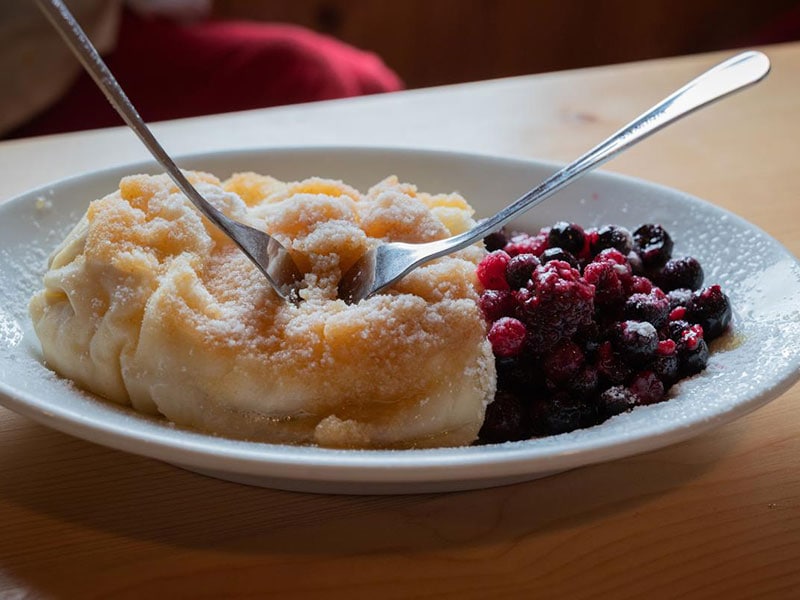
Štrukli, a tasty cheese dumpling, is a culinary treasure enjoyed in various regions. This dish features a delicate filo pastry enveloping a flavorful filling of your choice. Typical ingredients for the filling include sour cream, ricotta, eggs, and aromatic tarragon.
However, the possibilities extend to include options like nuts, baked fruits, and more. The finished dumplings can be coated with a luscious layer of butter or sour cream, adding richness and enhancing the flavors.
Štrukli can be prepared as both savory or sweet, providing a versatile dining experience. Cooking methods for Štrukli are diverse, ranging from steaming and baking to pan-frying. It’s important to note that Štrukli can sometimes be confused with Zagorski Štrukli, a famous dish from the Hrvatsko Zagorje and Zagreb regions in Croatia.
FAQs
Wrap-Up: The Taste of Heritage
Exploring traditional Central European dishes has been a tantalizing culinary revelation. From the Maultaschen to the enticing Babka, each dish tells a fascinating story.
I encourage you to delve deeper into this diverse food culture, try your hand at these recipes, and share your experiences. Let’s keep the conversation alive in the comments section below, and don’t forget to hit the like and share buttons!
References
- UNA-GB, W. by (no date) All about Poland and pierogi.
- Cafe konditorei fürst (no date) Histouring.
- Sachertorte (no date) DBpedia.
- Johnstone, L. (2019) Currywurst at 70: The surprising British link to Germany’s Street Food, euronews.
- Zaino, C. (2022) Tracing fondue’s mysterious origins, BBC Travel.

